
Side chair, Boston, ca. 1700. Maple and oak; original leather upholstery. H. 34 1/4", W. 17 3/4", D. 14 3/4". (Courtesy, Wadsworth Atheneum.) In New York, Boston leather chairs of this type outnumbered carved examples approximately six to one.
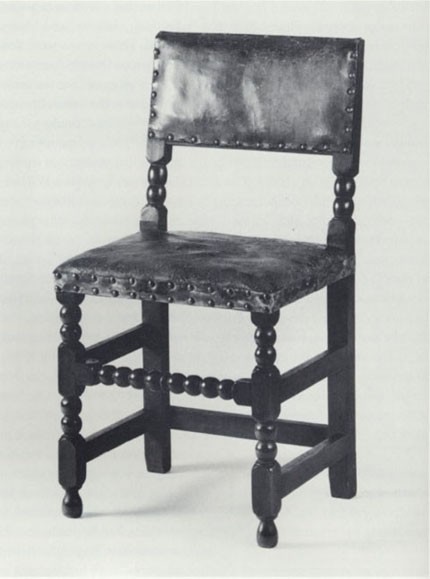
Side chair, Boston, 1650–1700. Birch and maple with ash. H. 35", W. 18", D. 15". (Courtesy, Winterthur Museum.)
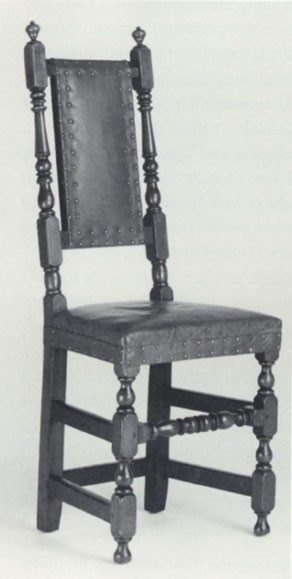
Side chair, New York City, 1705–1710. Maple and oak. H. 46 3/4", W. 18", D. 18 3/4". (Courtesy, Winterthur Museum.)

Map of Aunis-Saintonge, France.
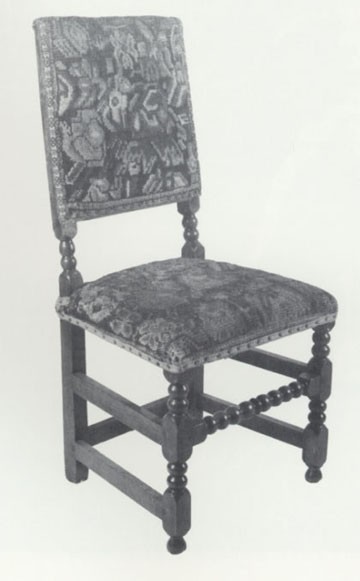
Side chair, Boston, 1690–1705. Maple and oak. H. 41 3/4", W. 20", D. 18". (Courtesy, New York State Education Department, Albany.)

Side chair, New York City, 1660–1700. Maple and oak; original seal skin upholstery. H. 36 3/4", W. 18 3/4", D. 15 1/2". (Courtesy, Old Saybrook Historical Society; photo, Gavin Ashworth.) The ball-and-cove and vase turnings on this chair differ from those on seventeenth-century Boston examples such as figs. 2 and 5. Seal skin was used when leather was unavailable.
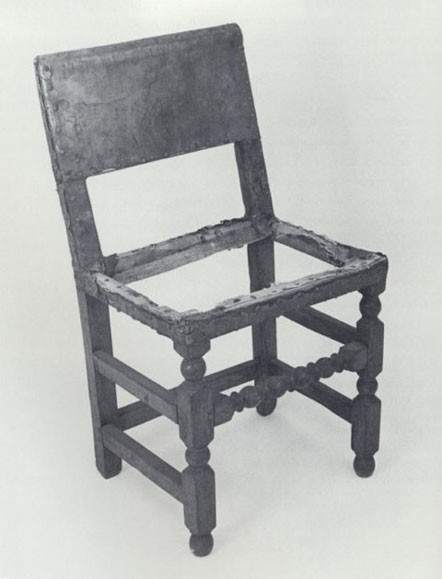
Side chair, New York City, 1660–1700. Oak and black ash; original leather upholstery. H. 34", W. 18 1/4", D. 15 1/2". (Courtesy, John Hall Wheelock Collection, East Hampton Historical Society; photo, Joseph Adams.) This chair descended in the Wheelock family of East Hampton, Long Island.

Side chair, New York City, 1660–1685. Red oak. H. 37", W. 18", D. 15 1/8". (Courtesy, Pocumtuck Valley Memorial Association, Memorial Hall Museum, Deerfield, Massachusetts; photo, Helga Studio.) The inverted vase-and-barrel turnings on this and another related example at the Wadsworth Atheneum followed Amsterdam prototypes in an era when Netherlandish design was on the wane in New York City.

Side chair, New York City, 1685–1700. Maple and oak. Dimensions not recorded. (Private collection; photo, Gavin Ashworth.) The turnings on this chair are closely related to those on late-seventeenth-century London cane chairs and early-eighteenth-century New York leather chairs, such as the one illustrated in fig. 3.

Grand Chair, New York City, 1680–1695. Maple stained red. H. 44 1/4", W. 22 1/2", D. 17 1/4". (Private collection; photo, Christopher Zaleski.)
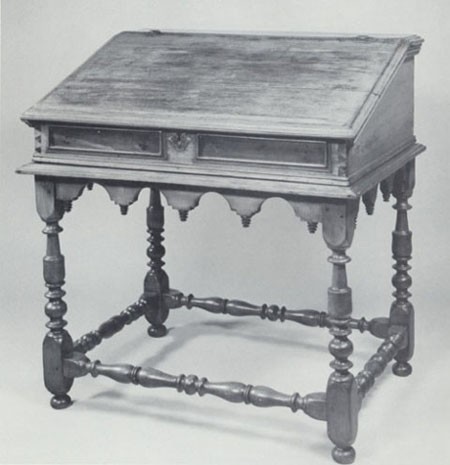
Escritoire, New York City or northern Kings County, 1695–1720. Desk-on-frame, gumwood, possibly walnut veneer, tulip poplar. H. 35 1/4", W. 33 3/4", D. 24". (Courtesy, The Metropolitan Museum of Art, Rogers Fund, 1944, acc.44.47, All rights reserved, The Metropolitan Museum of Art) The turnings on the side stretchers are closely related to those on the front stretcher of the grand chair illustrated in fig. 10.
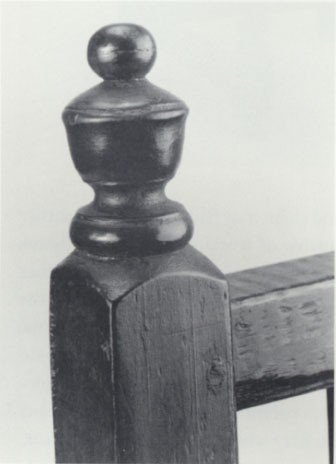
Detail of the finial of the grand chair illustrated in fig. 10. (Photo, Christopher Zaleski.)
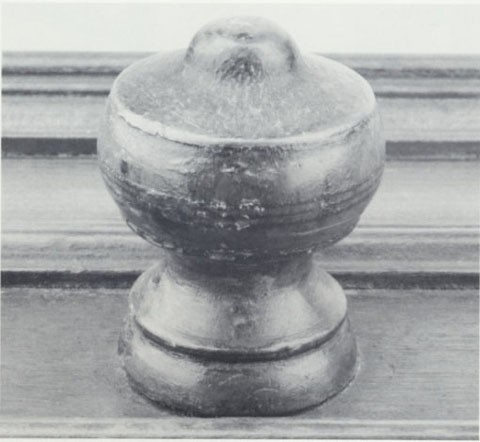
Detail of a drawer pull on a kast, New York City or northern Kings County, ca. 1700–1740. Red gum, mahogany, white pine, tulip poplar, 82 1/2 x 75 3/8 x 28". (Courtesy, Milwaukee Art Museum, Layton Art Collection L1994.3)

Side chair, New York City, 1705–1710. Maple and oak; original leather upholstery. H. 47 3/4", W. 18 1/2", D. 18 3/4". (Chipstone Foundation; photo, Gavin Ashworth.)

Detail of the finial of the side chair illustrated in fig. 14. (Photo, Gavin Ashworth.)
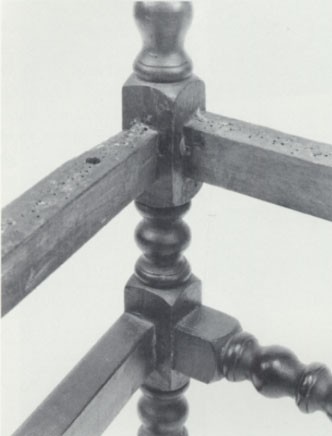
Detail of the understructure of the trapezoidal seat of the grand chair illustrated in fig. 10. (Photo, Christopher Zaleski.)
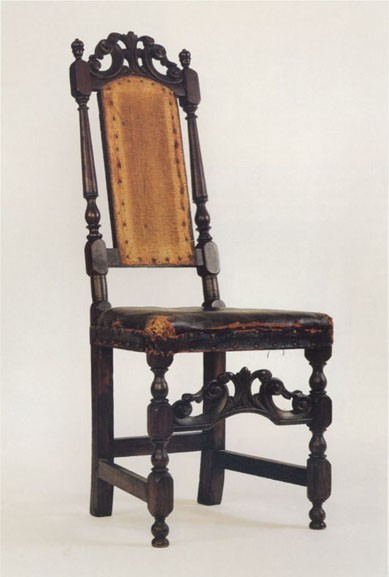
Side chair, Boston or New York City, ca. 1700. Maple and oak. H. 47", W. 20", D. 21". (Private collection; photo, Christopher Zaleski.) This chair, branded “PVP” for Philip Verplank of Fishkill, New York, is related to three carved leather chairs at Washington’s Headquarters, Newburgh, New York. The latter are also branded “PVP.”

Detail of the understructure of the side chair illustrated in fig. 17. (Photo, Christopher Zaleski.)
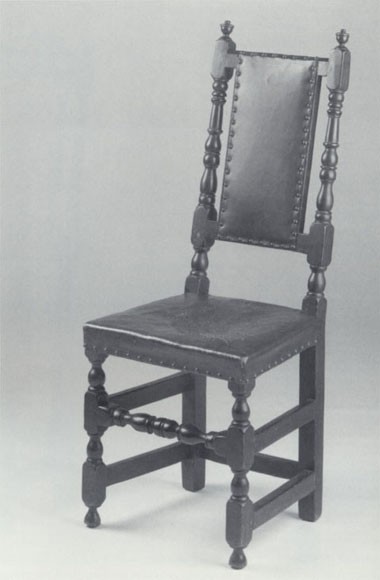
Side chair, New York City, 1700–1725. Maple with oak. H. 45 5/8", W. 18 1/8", D. 15 1/4". (Courtesy, Milwaukee Art Museum, Layton Art Collection L1982.116; photo, Richard Eells.) This chair reportedly descended in the Pieter Vanderlyn family of Kingston, New York. Pieter immigrated to New York City from the Netherlands in 1718. His arrival date suggests he may have acquired the chair from an earlier owner.

Detail of the “French hollow” back of the side chair illustrated in fig. 19. The curvature is similar to that of the early carved leather chair illustrated in fig. 39

Cane chair, London, ca. 1700. Beech. Dimensions not recorded. (Private collection; photo, Neil D. Kamil.)
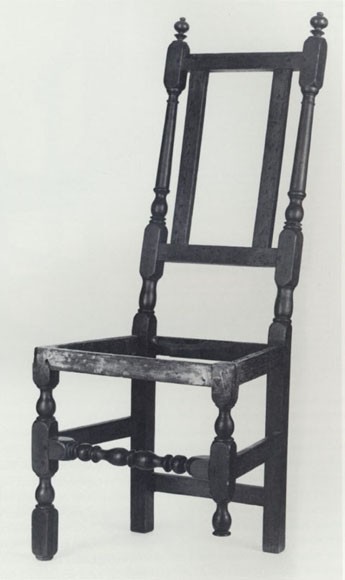
Side chair, New York City, ca. 1700. Maple. Dimensions not recorded. (Private collection; photo, Gavin Ashworth.) The front stretcher is related to that of fig. 10. The feet and a portion of the right leg are missing.
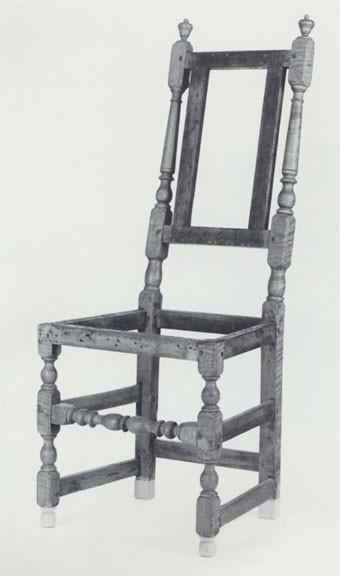
Side chair, New York City, ca. 1700. Maple. Dimensions not recorded. (Private collection; photo, Gavin Ashworth.) This chair is closely related to the one illustrated in fig. 22.
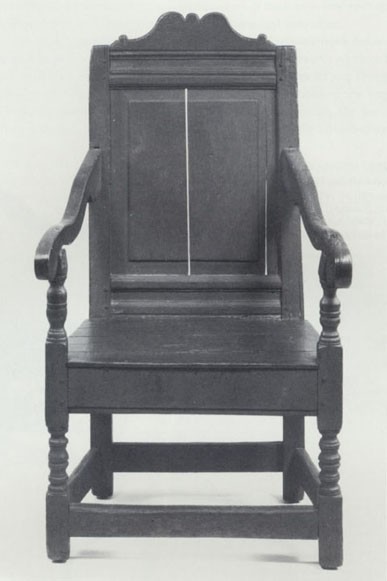
Joined great chair, New York, 1650–1700. Oak. H. 43", W. 23 3/4", D. 21". (Courtesy, Wallace Nutting Collection, Wadsworth Atheneum, gift of J. P. Morgan; photo, Joseph Szaszfai.) The left arm and seat are replaced, and the feet are missing.
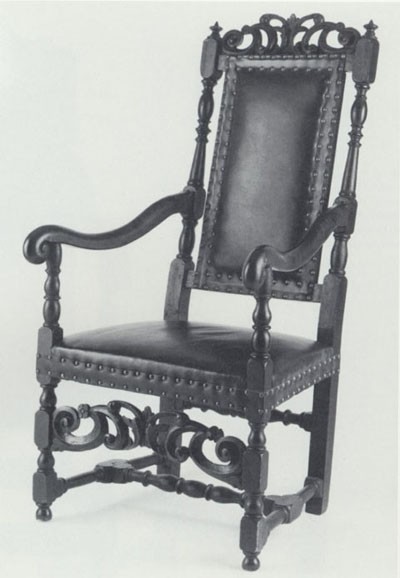
Armchair with carving attributed to Jean Le Chevalier, New York City, 1705–1710. Maple with oak and hickory. H. 47 1/2", W. 25 1/2", D. 27". (Courtesy, Historic Hudson Valley; photo, Gavin Ashworth.) The finials are incorrect nineteenth century restorations; the feet are more recent.
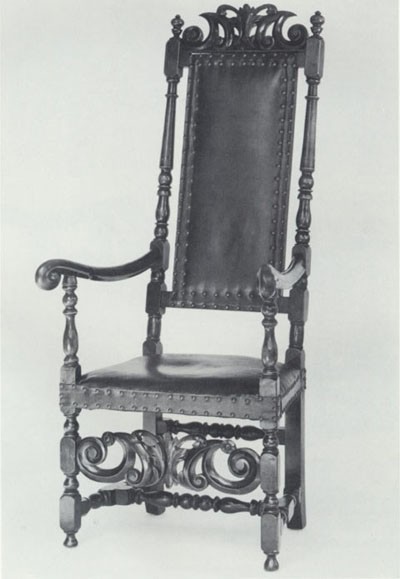
Leather great chair with carving attributed to Jean Le Chevalier, New York City, 1710–1730. Maple with oak. H. 53 3/4", W. 23 7/8", D. 16 3/8". (Courtesy, Museum of Fine Arts, Boston. Reproduced with permission. ©2000 Museum of Fine Arts., Boston. All rights reserved. Gift of Mrs. Charles L. Bybee; photo, Edward A. Bourdon, Houston, Texas.) This chair was damaged by fire while in the Bybee collection.
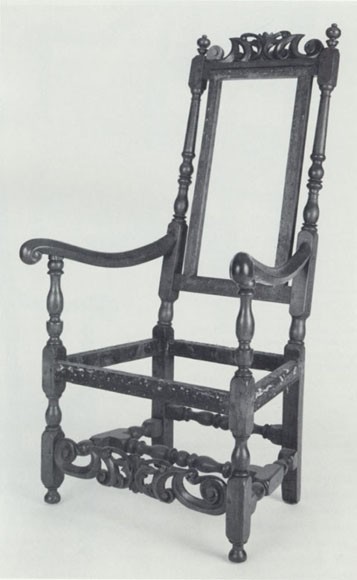
Armchair with carving attributed to Jean Le Chevalier, New York City, 1705–1710. Maple with oak. H. 52", W. 24 3/4", D. 17 1/2". (Chipstone Foundation; photo, Gavin Ashworth.) The low placement of the carved front stretcher is reminiscent of late seventeenth-century French fauteuils as well as some varieties of contemporary London cane chairs, which took French court furniture as a stylistic paradigm under the influence of refugee Huguenot artisans, especially after 1685. The left scroll volute of the crest is a replacement.
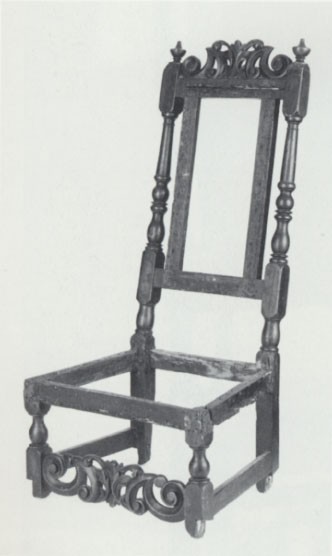
Side chair with carving attributed to Jean Le Chevalier, New York City, 1705–1710. Maple with oak. Dimensions not recorded. (Private collection; photo, Gavin Ashworth.)

Composite detail showing (from top to bottom) the crest rails of the chairs illustrated in figs. 26, 27, and 28 and the stretcher of the chair illustrated in fig. 25.
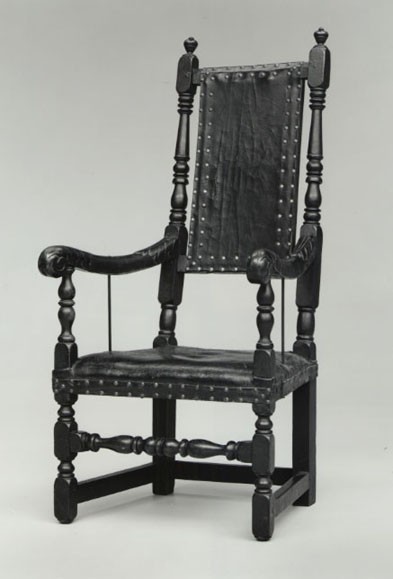
Armchair, probably Boston, Massachusetts, 1700–1710. Maple with oak; original leather upholstery. H. 47 1/2", W. 23 3/4, D. 17 3/4". (Courtesy, Museum of Fine Arts, Boston. Reproduced with permission. ©2000 Museum of Fine Arts, Boston. All rights reserved. Arthur Tracy Cabot Fund, 1971.624.) Acanthus-carved arms such as these were common on late-seventeenth- and early-eighteenth-century French upholstered seating furniture.
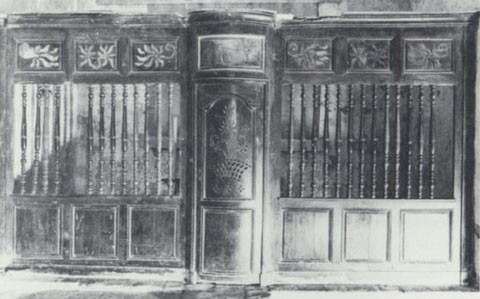
Baptismal screen in the church of St. Étienne, Ars-en-Ré, Île de Ré, France, 1625–1627. Oak. (From Inventaire Général des monuments et des Richesses Artistiques de la France, Commission Régionale de Poitou-Charentes, Charente-Maritime, Cantons Île de Ré; photo, Christopher Zaleski.)

Detail of the baptismal screen in the church of St. Étienne, Ars-en-Ré, Île de Ré, France, 1625–1627. Oak. (From Inventaire Général des monuments et des Richesses Artistiques de la France, Commission Régionale de Poitou-Charentes, Charente-Maritime, Cantons Île de Ré; photo, Christopher Zaleski.)
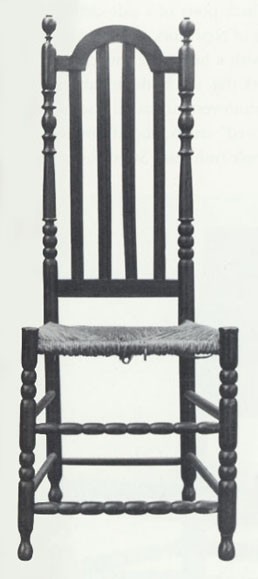
Black chair, Long Island Sound region, perhaps southeastern Westchester County, 1705–1730. Maple and ash. Dimensions not recorded. (Dey Mansion, Wayne Township, New Jersey; photo, Neil D. Kamil.)

Black great chair, probably Tarrytown, Westchester County, 1705–1730. Woods unidenti€ed. H. 44 1/2", W. 25", D. 26 1/4". (Courtesy, Historic Hudson Valley.)
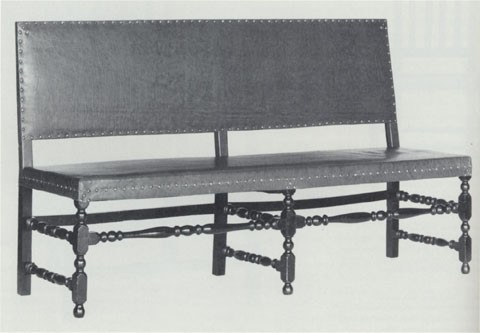
Couch, New York City or coastal Rhode Island, 1700–1715. Maple. H. 42 1/8", W. 74 3/8", D. 25 1/8". (Courtesy, Winterthur Museum.)
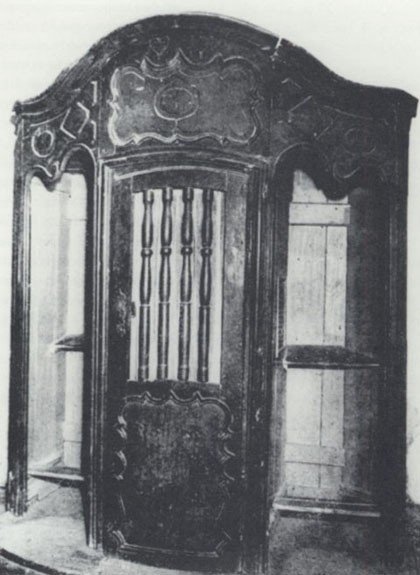
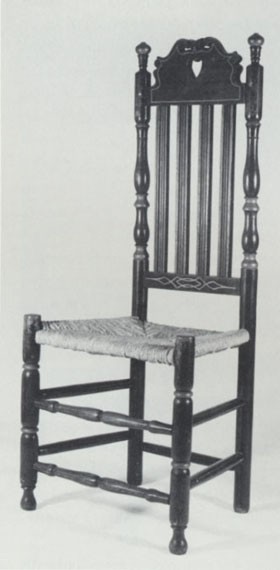
Side chair attributed to Pierre or Andrew Durand, Milford, Connecticut, 1710–1740. Maple and ash. H. 45 1/4", W. 19 1/2", D. 14 3/4". (Anonymous collection; photo, New Haven Colony Historical Society.)

Side chair, probably London, 1685–1700. Woods and dimensions not recorded. (Photo, Symonds Collection, Decorative Arts Photographic Collection, Winterthur Museum.)

Side chair, London, 1690–1700. Beech with turkeywork cover. H. 48 3/4", W. 21 7/8", D. 17 5/8". (Courtesy, Museum of Fine Arts, Boston. Reproduced with permission. ©2000 Museum of Fine Arts, Boston. All rights reserved; Gift of Mrs. Winthrop Sargent, in memory of her husband 17.1629.)
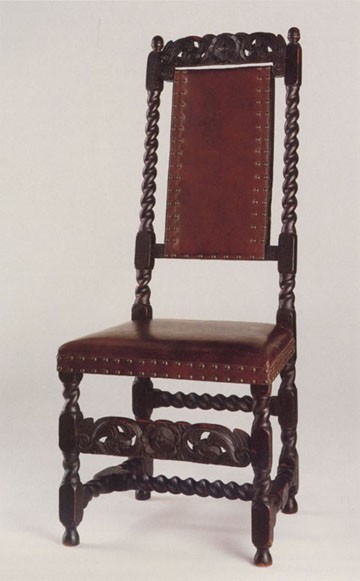
Side chair, New York City, 1685–1700. Maple. H. 48", W. 20 1/4", D. 22". (Chipstone Foundation; photo, Gavin Ashworth.)
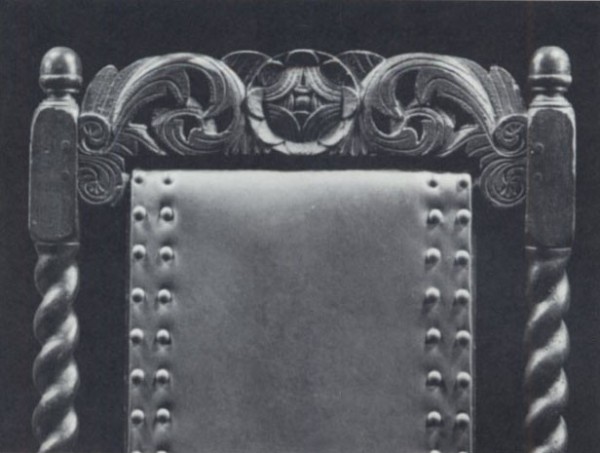
Detail of crest rail, posts, and finial of the side chair illustrated in fig. 39. (Photo, Gavin Ashworth.)
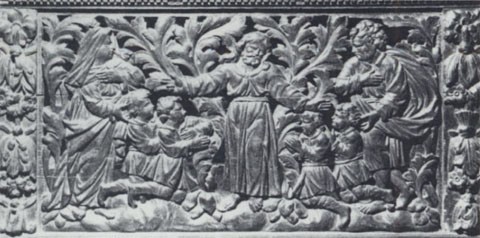
Details of three carved panels on the choir screen in the church of St. Étienne, Ars-en-Ré, Île de Ré, components ca. 1629: (a) Christ gathering his flock; (b) acanthus-leaf foliage; (c) winged cherubs holding an urn. Oak and walnut. (From Inventaire Général des monuments et des Richesses Artistiques de la France, Commission Régionale de Poiton-Charentes, Charente-Maritime, Cantons Île de Ré; photo, Christopher Zaleski.)
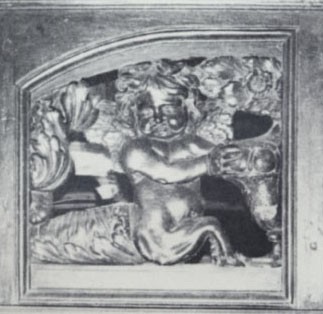
Detail of one of the earliest panels in the choir screen in the church of St. Étienne, Ars-en-Ré, Île de Ré, ca. 1580. (Photo, Christopher Zaleski.)
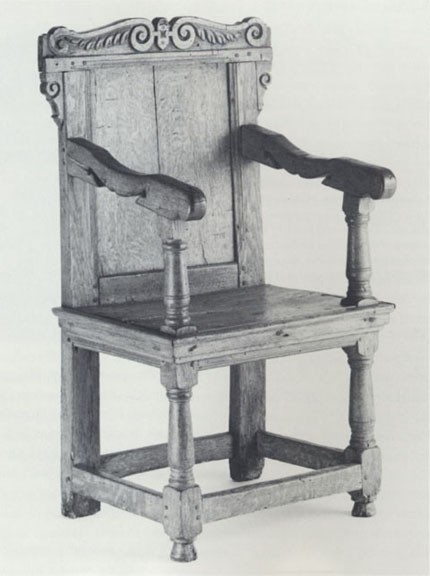
Joined great chair, probably New York City, ca. 1675. Oak. H. 42 1/2", W. 25", D. 22 1/2". (Courtesy, Winterthur Museum.) Jean Le Chevalier’s grandfather, “Jan Cavelier,” was one of the most important carvers in New York during the era when this chair was made.

Detail of the carved crest rail of the great chair illustrated in fig. 43. (Courtesy, Winterthur Museum.) The compressed, diamond-shaped aperture surmounted by a lunette at the nexus of the opposing scrolls is repeated in the carving of the sunflower on the crest rail of the New York leather chair illustrated in figs. 39, 40.
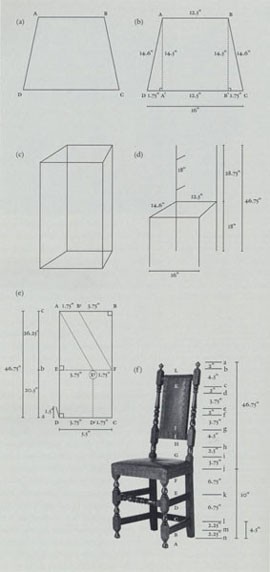
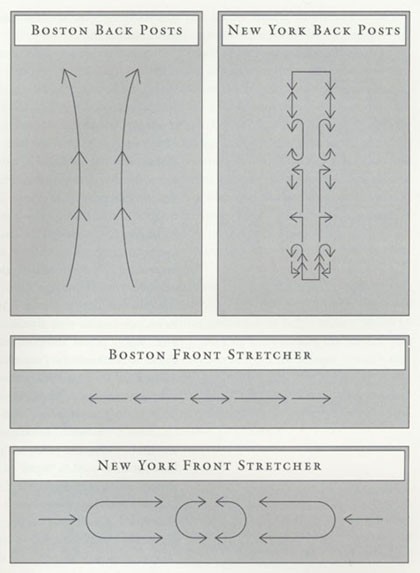
Flow diagram representing the formal opposition of turning patterns on Boston and New York plain leather chairs, exempli€ed by figs. 1 and 3, respectively. (Drawing, Neil D. Kamil; art work, Wynne Patterson.)
October 29, 1716 Monday. New York . . . I walked round this town. There is here three churches, the English church, the French and the Dutch church. . . . The French have all the privileges that can be in this place and are the most in number here. They are of the council, of the parliament, and in all other employments here.
—John Fontaine, Huguenot traveler
“Ingate” and “Outgate”: Dialogues about Words and Things
The current state of New England regional studies indicates that traditional notions of dominance and cultural homogeneity are finally undergoing revision. Recent scholarship suggests that the once “monolithic” Puritan region was settled intermittently by diverse groups of migrants, not only from a variety of East Anglian settlements, but from all over England and America. Given our awareness of the limitations of this traditional assumption, it is ironic that historians of colonial America who venture into the middle Atlantic region must again confront similarly reductive and one-dimensional ethnic models.[1]
The most enduring scheme of ethnic reductiveness in middle Atlantic regional studies is the one that posits successive Dutch and then English cultural hegemony in colonial New York, with 1664—the date of the English imperial conquest of the colony—representing the chronological break between the two periods. Transatlantic historians might well ask, how does one even begin to define the pluralistic, shifting Netherlands in such monolithic “Dutch” terms? One must also consider persuasive quantitative evidence that, although New Netherland came into being as a Dutch West India Company, the colony never had an effective ethnic Dutch majority. Indeed, many of the earliest colonists were French-speaking Huguenots and Walloons who came in search of refuge and economic opportunity. Immigrants from all over Protestant Europe, African slaves, and local native groups combined to make New York City and its dauntingly large hinterland among the most pluralistic societies in colonial America. This social and geographic context has enormous implications for understanding the fluid history and culture of New York Colony.[2]
The stereotype of “pure Dutchness” owes much to the nostalgic ethnic myths and fairytales popularized by New York’s nineteenth-century essayist and historian Washington Irving (1783–1859), particularly his Dietrich Knickerbocker’s A History of New York (1809). This perception powerfully shaped the historiography of New York and limited the analysis of the colony’s many other important and linguistically distinct subgroups,which were engaged in constant cultural conflict and accommodation on many levels of interaction. The real story of New York’s material culture was not about Dutchness or Englishness per se but rather about ethnic and cultural diversity, within which both the Dutch and the English played their proper roles.[3]
The French words for “furniture” (“mobilier” or “meubles”) are defined literally as “moveables,” and one way to begin understanding such ambiguous issues as regional identity in diverse colonial settings, ethnic stereotypes, and cross-cultural conflict and accommodation is by considering the journey (or diffusion) of an instantly recognizable colonial artifact—the Boston “plain” leather chair (fig. 1). Thanks largely to the work of furniture historian Benno M. Forman, we now know that because of intercoastal trade the Boston leather chair—a shoddily made, provincial adaptation of the fashionable, London cane chair—probably was the single most influential moveable produced in colonial America between the Restoration and the end of the French and Indian War. Forman’s main concern was what he and most other art historians of his generation called connoisseurship, an intensely “presentist” word directed towards highly subjective questions of universal quality and difficult to define or contextualize historically; nevertheless, because of his research, we can readily separate leather chairs made in Boston, New York, Philadelphia, and other coastal style centers and focus on new sets of questions and concerns.[4]
What, after all, was the leather chair’s significance as it was carried as merchant cargo from place to place in the colonies, inspiring local copies nearly everywhere it was sold? Why were “style” and “fashion” such key words for the artisans, merchants, and consumers of leather chairs in the port towns of early-eighteenth-century America?
Historically, the Boston leather chair’s significance centers on its role as an important English symbol for colonial elites. Made primarily for export to the middle Atlantic region and the South by a network of Boston chairmakers and upholsterers, the chair remained at the nucleus of New England’s coastal furniture trade for more than a century. New York City and western Long Island were among the most important markets; however, only the elite owned leather chairs. A survey of 560 inventories probated between 1700, when the new, high-backed leather chair first made its appearance, and 1760, when appraisers consistently described a later version of that form as old, very old, or old-fashioned, indicates that only thirty-one households (5.5 percent) possessed leather chairs.
These were important households, however; the average valuation of estates that list leather chairs was £982.8.[5] The chairs were clearly luxury items, and they ranged in value from 10s to £3 or more apiece depending on model and condition. Most significantly, households valued near the average were seldom without at least one leather chair, indicating that they were a necessary symbol of status for New York’s elite. Owners were generally “merchants” or “gentlemen” who lived in the city, where 77.4 percent of all leather chairs were inventoried. The remainder were evenly distributed in Flushing, Jamaica, and Hempstead, the largest towns on western Long Island. These towns were also the traditional strongholds of New York’s prosperous Quaker community.
So widespread was the trade in leather chairs that some colonial officials protested to the British Board of Trade that New England artisans and merchants were undermining the spirit of the Navigation Acts by infringing on England’s natural prerogative to provide her colonies with manufactured goods. In a contentious report presented to Parliament on January 22, 1733, Lieutenant Governor William Gooch of Virginia complained that “scrutoires, chairs and other wooden manufactures . . . are now being exported from thence to the other plantations, which, if not prevented, may be of ill consequence to the trade and manufactures of this kingdom.”[6] Gooch’s report clearly reflects the fact that his constituents in the Chesapeake produced tobacco, grain, and cattle for export, not chairs.
To compensate for the lack of an overarching staple, New England merchants and artisans produced and exported chairs and other manufactured goods so aggressively that transatlantic economic historians now conclude New England’s mercantile strategy was to assume consciously the role of English metropolis in the New World. According to historians John J. McCusker and Russell R. Menard, “New England resembled nothing so much as old England itself. And that, of course, was the problem. . . . It was in the expansion of domestic processing and manufacturing, of a far-reaching export business . . . that New Englanders . . . mounted a growing challenge to the hegemony of the metropolis.”[7]
By 1700, the middle Atlantic, southern, and Caribbean plantation economies, which exploited slave labor to extract and refine staple commodities, had far outdistanced New England in terms of direct credits with metropolitan England and the empire’s Atlantic market. The Massachusetts General Court had become conscious of this imbalance as early as the empirewide depression of the 1630s and 1640s. In New England, the depression intensified as immigration (the colony’s main source of liquid capital) dropped off following the great Puritan migration of the 1630s. Having observed that “our ingate [imports]” were “to exceed our outgate [exports]” such that “the ballance needs be made up,” the court passed the Edict of 1646. This decree allowed for the active development of local manufactures in explicit competition with the metropolis, thus addressing the crippling structural problem in the colony’s balance of trade.[8] The export of such new manufactures as clothing, shoes, boots, ironware, and chairs was one of the only means available for New England merchants and artisans to boost exports back into balance.
Shortly after the edict, upholstered chairs were among the most common items of New England manufacture carried south on sloops from Boston. Indeed, by the 1670s, references to the earliest form of low-backed, leather upholstered New England chair or “stool” (fig. 2) appear in Maryland inventories. By 1700, appraisers in every colony were specifically referring to leather chairs as either Boston, New England, or Boston Made. The artifactual language of the Boston leather chair thus proved distinctive enough to warrant the acceptance of new terminology into colonial discourse. In the small world of North American commerce, the chair became a medium for intercolonial communication.[9]
But what could chairs communicate? What were the cultural associations that the word “Boston” carried with the chair on its journeys south into the regions of staple production? What, beyond its point of origin, were the signifiers of its Bostonness? Such implicit cultural associations attending the chair trade were imperative to Boston’s mercantile strategy. From 1646 until at least the 1730s, Boston acted as the mother country’s cultural broker, albeit without her approval. As far as furniture was concerned, Boston was a veritable Anglo-colonial metaregion for elites in other colonies seeking fashionable goods.
Acting as surrogates for the core culture on its colonial periphery, Boston merchants and artisans proclaimed their unique power to produce and disseminate authentic novelties of English metropolitan style. Such novelties were a necessity for aspiring colonial elites consumed with anxiety about falling behind their counterparts in London. As historian William Smith Jr. observed in his History of the Province of New-York From the First Discovery to the Year 1732 (1757), “In the city of New-York, through our intercourse with the Europeans, we follow the London fashions; though by the time we adopt them, they become disused in England. Our affluence . . . introduced a degree of luxury in tables, dress, and furniture, with which we were before unacquainted. But we are still not so gay a people, as our neighbors in Boston.”[10]
Nowhere was Boston’s stake in controlling the discourse of novelty and style more evident than in the frequent correspondence between Boston merchant and upholsterer Thomas Fitch (1668/9–1736) and Benjamin Faneuil (b. La Rochelle 1658, d. New York 1719). Faneuil was Fitch’s principal agent in New York and a French Huguenot merchant exiled from the great Protestant fortress town of La Rochelle—a place that looms large in the transatlantic history of the Reformation and Counter Reformation. Benjamin, his immensely wealthy son Pierre (b. New York 1700, d. Boston 1742), and brother André (b. La Rochelle 1657, d. Boston 1737) established one of the most important refugee trading firms in early-eighteenth-century America. The Faneuil family’s importance resulted not only from the emergence of a strong Boston–New York coastal axis but also from the family’s longstanding transatlantic financial connections to other relatives and members of its patronage network still living in La Rochelle, as well as in Rotterdam and New France.[11]
Fitch’s letters concern multiple shipments of leather chairs from Boston to New York, and they demonstrate how important the coastal furniture trade was to Boston’s merchant elites and their clientage networks in the early eighteenth century. They also inform and complicate historian Robert J. Gough’s reconsideration of the arbitrary geographical boundaries usually assigned to the “middle colonies.” Gough suggests that the middle colonies were actually comprised of two distinct “human regions”:
New York, parts of western Connecticut, eastern New Jersey, and the northeast corner of Pennsylvania comprised one region. Most of Pennsylvania, part of Maryland, and all of western New Jersey and Delaware formed another. Each region had peculiar characteristics, and the inhabitants of each interacted mostly with themselves. What inter-regional contacts they did have tended to be with the South, for the Philadelphia-centered region, and with New England, for the New York-centered region. Each region was different from the South and from New England in important respects, to be sure, but for different reasons and in different ways.[12]
Although this essay underscores a strong interregional socioeconomic and cultural connection between New England and New York during the late seventeenth and early eighteenth centuries, it also considers transatlantic extensions of New York’s human region.
Transatlantic concerns clearly influenced Fitch’s performance as cultural broker and the acceptance of that performance in New York. Fitch maintained social distance and cultural dominance over Faneuil precisely because of his self-proclaimed knowledge about what was stylish in Londonand Boston. Fitch’s letter of April 22, 1707, in which he chastized Faneuil for ordering something out of fashion in both London and Boston, is the best example of the asymmetry of the patronage relationship between this fully Anglicized Boston merchant and his French refugee client: “Sir . . . leather couches are as much out of wear here as steeple crowned hats. Cane couches or others we make like them . . . are cheaper, more fashionable, easy and useful.”[13]
Faneuil and some of his fellow New Yorkers, however, did not sit idle while Fitch and others flooded the affluent New York market with Boston leather chairs. Fitch was so overwhelmed with orders from New York by 1706 that he wrote Faneuil, “I would have sent yo some chairs but could scarcely comply with those I had promised to go by these sloops”; yet, three years later there was a glut of leather chairs on the market for the first time. On September 9, 1709, Fitch began a series of anxious letters that despaired of Faneuil’s inability to sell his consignment: “I wonder the chairs did not sell; I have sold pretty many of that sort to Yorkers, . . . and tho some are carved yet I make it six plain to one carved; and can’t make the plain so fast as they are bespoke. So you can assure them that are customers that they are not out of fashion here. . . . I desire that you would force the sale of the chairs. . . . I also submit the price of them to your patience. It’s better to sell them than to let them lie.” Fitch added, “It might be better to have them rubbed over that they may look fresher,” even though the expense of polishing would come out of his rapidly diminishing profit margin.[14]
Boston plain leather chairs had enjoyed uninterrupted popularity in New York for more than a decade (or for more than forty years, if one includes earlier related seating forms), so Fitch’s exasperation was understandable. Even his old trumpcard to sway the presumably unanglicized elites in New York—his protestation about the chairs’ stylishness in Boston—failed to bolster sales. What had changed? To begin, New York chairmakers began producing a modified version of the Boston leather chair by the end of the seventeenth century (fig. 3). Subsequently, several New York shops produced a number of variants, all incorporating recognizable features of the Boston chair. By 1709, they supplied enough competition to cut into Fitch’s formerly secure market. We thus begin to see, on a very local level and in just one sort of export manufacture, early evidence of the unraveling of Massachusetts’s mercantile strategy outlined in the Edict of 1646.
As historians Jack P. Greene, John McCusker, and Russell Menard have demonstrated, even those regions engaged primarily in the exploitation of staple agriculture diversified by developing an artisanal component to compete with New England’s export market in manufactured goods. Relative population growth is a good general indicator of the potential for regional development of the artisan sector. In 1660, New England’s total population (including slaves) exceeded 33,000, while the middle colonies’ was less than 6,000 (a ratio of over 5:1). But by 1710, while New England’s population had grown to 115,000, the middle colonies’ increased to nearly 70,000 (a ratio of less than 2:1). Beginning in 1705, a flurry of correspondence criss crossed the Atlantic, indicating for the first time that London’s Board of Trade saw New York’s growing manufacturing sector as a potential threat to British mercantilism.[15] New York had begun to replicate elements of Boston’s mercantile strategy successfully enough to gain notice both in Boston and the metropolis.
Still, why would New York be among the first colonies to support an artisan sector powerful enough to respond so rapidly to a formidable mercantile engine largely in place in New England since the 1640s? Given Fitch’s condescending attitude toward Faneuil, it seems ironic that many of the artisans and merchants who ultimately usurped Fitch’s enterprise were from southwestern France, particularly coastal Aunis and Saintonge, La Rochelle’s hinterland (fig. 4). La Rochelle was the birthplace of Benjamin Faneuil, and the Aunisian and Saintongeais refugee immigrants—many of whom shared Old World trade or family associations—comprised the majority of his craft network.[16] La Rochelle was also the last great Protestant fortress town to resist the Catholic state, until it fell to Richelieu and Louis XIII in a year-long siege in 1628—a genocidal Counter Reformation event that claimed the lives of nearly 20,000 heretics with brutal efficiency. The fall of La Rochelle effectively broke the back of Huguenot military resistance in the western provinces, thus setting the stage for Louis XIV’s Revocation of the Edict of Nantes in 1685, which outlawed reformed religion in France and signaled the beginning of the final, massive Huguenot dispersion to Protestant northern Europe and the New World.
The Year 1685 and New York’s “Old” Culture
Although 1685 was the starting point for the largest migration of Huguenot artisans from Aunis-Saintonge to New York, the foundation for the city’s leather chairmaking industry was laid earlier, since its pluralistic artisan sector developed along with its population. Until the late 1680s, the vanguard of the “Protestant international” in New Amsterdam–New York had consisted of family networks of merchants and artisans from Dutch, Germanic, and Scandanavian regional cultures, Walloon refugees from the Spanish Netherlands (who spoke a French dialect), and “old” diaspora Huguenots who founded churches in exile among sympathetic hosts throughout the North Atlantic reformed community by the 1550s.[17] The Huguenots of the dispersion were the final and primary catalyst that enabled New York’s artisans to compete successfully with Boston imports and challenge that city’s role as disseminator of metropolitan style and fashion.
On April 16, 1705, Fitch wrote Faneuil, “Please to inform me in yor next whether Turkey worke chairs would see with yo, If yo think they will shall send yo some from 15 to 20s a ps here.”[18] Presumably, these chairs were Boston-made, high-backed stools similar to the one illustrated in figure 5. Although no response to Fitch’s letter survives, Faneuil probably replied negatively, since this type of chair was outdated in London and Boston.[19] Fitch often remarked that New York was behind fashion, and he probably assumed that turkeywork chairs might still be stylish there.
Fitch evidently underestimated and misunderstood the development and sophistication of New York tradesmen and consumers. Inventories indicate that high-backed stools were out of fashion by 1701. Huguenot “Captain” Nicholas Dumaresq[ue]’s inventory, taken on June 12, 1701, listed “four old high Leather Chairs” and “one old Low chair.” Given the proximity and similar language of these listings, the “old Low chair” probably resembled the ones illustrated in figures 2 and 6–9. Appraisers often used the term “old” interchangeably with “old-fashioned,” and in this case, “old” probably referred to style rather than condition.[20]
By 1701, two predecessors of the new plain leather chairs were anachronistic in both Boston and New York. What is most significant, however, is that a great variety of low-backed leather, turkeywork, and other woolen upholstered chairs were apparently manufactured in New York during the late seventeenth century (figs. 6-9), but not enough to challenge effectively the Boston trade. Nevertheless, several shops from various cultural traditions were clearly established to lay the socio-material foundation for New York’s powerful cultural response—spearheaded by the Huguenot immigration from Aunis-Saintonge after 1685—to the introduction of Boston leather chairs like those exported by Fitch (fig. 1).
If the “old high Leather chairs” in Dumaresque’s inventory were made in one of New York’s earliest shops, rather than in Boston, they may have resembled the grand chair frame illustrated in figure 10. Evidence suggests that this late-seventeenth-century “high [upholstered] chair” is a rare colonial interpretation of the Parisian “grand” chair, a form that appeared mainly in France and on the Continent around 1670 (the grand chair seemed, anomalously, not to have proven fashionable in London). More importantly, this example is a New York–made predecessor for the high-backed leather chair form introduced during the early eighteenth century (fig. 1).[21]
In formal terms, the design of the grand chair’s turned front stretcher relates directly to the side stretchers of a New York escritoire (fig. 11) with a Dutch inscription detailing a business transaction and the date 1695 under its lid. The escritoire and the grand chair, however, could date as early as the mid-1680s, when the word “escritoire” first begins to appear in New York inventories. This escritoire has long been considered a keystone for understanding late-seventeenth-century urban New York cabinetmaking. Collected from a house on Cortelyou Road in the Flatbush section of Kings County early in this century, it may have been made in Brooklyn or brought there from New York City.[22]
Certainly the escritoire, like the grand chair, may have originated in either place, because competent artisans capable of working in “urban” idioms existed on both sides of the East River—a waterway that connected rather than separated these areas. The accessibility of lower Manhattan to the northern tip of Brooklyn—a brief ride on the Long Island ferry across the lower East River, and so easily accessible to the docks or the business end of New York City—is confirmed by the diary of John Fontaine, an Anglo-Irish Huguenot of southwestern French parentage who wrote on October 29, 1716: “About eleven we came to the ferry which goes over to New York. There is a fine village [Brooklyn] upon this island opposite to New York. The ferry is about a quarter of a mile over, and water runs very rapidly here, and there is good convenient landings on both sides. About 12 we landed at New York.” Fontaine’s appraisal of Manhattan’s roads was far less encouraging: “[They] are very bad and stony, and no possibility for coaches to go only in the winter when the snow fills all up and makes all smooth, then they can make use of their wheel carriages. There is but two coaches belonging to this province though many rich people, because of the badness of the roads.”[23]
By the late seventeenth century, Kings County surveyors had established a passable network of roads, which connected all the major western towns to the Long Island ferry. The stylistic relation of New York City to Kings County furniture is thus a difficult problem to unravel with utter assurance. Consider the problems that accompany the neat separation of kasten with New York City and Kings County histories. These artifacts share many of the same details. Intraregional interaction is also suggested by the distinctive finial of the New York grand chair (fig. 12), which has much in common with drawer pulls found on a number of early New York City or King’s County kasten (fig. 13) and with the standard finial on its successor, the New York plain leather chair (figs. 14, 15). Moreover, between the English takeover and the Revocation, cross-generational, transatlantic, cultural continuities, solidified by strategic marriages that connected families, shops, regions, and neighborhoods, clearly played a significant role in the linkage and maintenance of New York’s most enduring continental craft networks. Some seventeenth-century Kings County artisans from New York’s “old,” pre-1685 Huguenot culture, including members of the Lott family of southwestern France, Amsterdam, and Kings County—plausible makers of both the escritoire and the grand chair—worked for elite patrons in New York City while simultaneously developing cheap land and maintaining numerous slaves in the more homogeneous continental towns across the river in Brooklyn. Quaker merchants and artisans followed a similar bifurcated yet symbiotic pattern on western Long Island since the time of Peter Stuyvesant’s restrictions on Quaker “conventicles,” which led to the publication of the Flushing Remonstrance on December 27, 1657.[24]
Material evidence strongly suggests that the maker of the grand chair (fig. 10) was of continental descent. The unusual carved arms with concave elbow rests relate less to turned and upholstered metropolitan prototypes than to joined great chairs made in the British midlands and west country. However, a more closely analogous arm occurs on an early-eighteenth-century turned armchair of vernacular French or Germanic origin.[25] There is also the distinct possibility that the New York armchair represents the collaborative work of a turner and a joiner—perhaps individuals from different cultural backgrounds. If so, this would further complicate the quest for ethnic origins in what is most likely a creolized chair.
Two of the most intriguing components of the chair are its trapezoidal seat and recessed back, which frames three squared, partially unfinished spindles (the surfaces have deep horizontal saw marks). The chairmaker constructed the trapezoidal seat by chamfering the front and rear ends of the seat lists and thick side stretchers at opposite though parallel angles, to accommodate the wider front (fig. 16). An alternative method commonly used on British and Boston examples was to leave the ends of the side elements cut flush, an economical technique that allowed for thinner stock, while chamfering the inside back of the two front posts beneath the seat, thus angling the posts instead of the stretchers (figs. 17, 18). It would be simplistic, however, to conclude that one solution was “continental” and the other “British,” since these conceptually opposite construction techniques commonly appear on chairs attributable to both Boston and New York.
Peter Thornton has demonstrated how seventeenth-century French and Low Country chairs had “bucket” seats or backs designed to contain removable, mattress-like carreaux (or “squabs”). The three rough-hewn spindles on the New York grand chair were not meant to be visible but rather to serve as tying posts for the carreau’s fasteners, probably made of woven ribbon or “tape.” Both transatlantic and cross-generational structural continuities are suggested by the height available for the carreau on the grand chair’s back, which measures 151/2 inches, as does the height of its seat. Reciprocal, one-to-one vertical symmetry remains constant on New York’s high-back leather chairs as well (see figs. 3, 45d), although not on Boston plain chairs. Boston chairs accentuate verticality, such that the height of the back typically exceeds that of the seat. The back structure of an unusual southern armchair at Colonial Williamsburg suggests that it also had a carreau; however, the framing members of the back are larger, and they are smooth planed and molded. The latter example possibly represents the work of a Huguenot tradesman from one of the large French settlements in the South Carolina Low Country.[26]
Although the upholstery materials used on the seat of the New York grand chair are unknown, nail holes indicate it had a sacking bottom (rather than girtwebbing) that was probably covered tightly by leather or a woolen. Print sources suggest that a high cushion may have surmounted the seat, rising to fill the gaping hole between the top of the frame’s seat lists and the bottom of its lofty stay rail. Presumably, the carreau and seat cushion had matching textile covers. In his discussion of continental seating styles, Thornton cites “a French chaire hollow in ye back.” To accommodate the shape of the sitter’s shoulders and ribs, such chairs had concave backs formed by subtly curving the crest and stay rails backward.[27] This feature principally occurs only on early-eighteenth-century New York leather chairs (figs. 19, 20) and may represent a Huguenot innovation.
The New York grand chair suggests by its very singularity that only a few were made. The advent of “new fashioned,” high-backed London cane (fig. 21) and Boston leather chairs, combined with the Parisian grand chair’s apparent rejection in London, assured that the latter form quickly passed out of fashion in New York. Fitch’s 1701 letter to Faneuil stressing the availability of presumably cheap, high-backed turkeywork chairs currently out-of-fashion in the metropolis indicates that he was intent on capturing what remained of the dwindling New York market for these luxury items. Evidently, the new, high-backed “Boston” plain leather chair was just coming into fashion in New York around the turn of the century.
Two high-back leather chairs made in New York about 1700 (figs. 22, 23) have the same seventeenth-century turning sequences as the grand chair (fig. 10). These are the only known high-back chairs of the later variety with these early turnings. Anomalous survivals such as these were undoubtedly considered anachronistic by the early eighteenth century, particularly when compared with new turning patterns drawn from fashionable London cane chairs. Fashion did not erase all memory of the grand chair however. For example, arm supports with bilaterally symmetrical balusters—a classical form that was updated and called a “double poire” (double pear) by French architect Charles Augustin d’Aviler in his Cours d’Architecture (1710)—appear on several early-eighteenth-century, high-back New York leather armchairs (see fig. 30).[28] The earliest New York example with this turned element is a joined great chair (fig. 24). Made a decade or two earlier than the grand chair, it attests to the longevity of this turning pattern; however, the “double poire” and urn finial with its proud boss turned in the round (figs. 10, 12) were the only parts of the short-lived New York grand chair consistently repeated on later upholstered furniture.
Human Geography and Material Life
By 1701 Fitch had enlisted Faneuil to act as a middleman and to persuade New Yorkers of every ethnic stripe that the leather chair was no less popular in English Boston than in heterogeneous New York. In that capacity Faneuil was able to maximize his personal power, as had generations of other multilingual Rochelais merchants in northern Europe and the British archipelago. Evidence suggests that Faneuil may have endured Fitch’s arrogant scorn to his eventual profit while serving as the upholsterer’s submissive apprentice in the subtleties of Anglo-Boston material culture. The profit, of course, came when Faneuil and his network of Huguenot artisans understood the social and cultural connotations of the Boston leather chair and quietly made it their own through adaptation and innovation.
The most compelling artifact asserting the role artisans from Aunis-Saintonge played in the New York leather chair industry after 1701 is a carved armchair made for Stephanus Van Cortlandt (1643–1700) or his son, Philip (1683–1748) (fig. 25).[29] Found among the family collections of the Van Cortlandt Manor in Croton, southern Westchester County, the armchair appears in a late-nineteenth-century photograph of the second-story hall.
Among the most distinctive features of the armchair are its carved crest rail and stretcher, both of which have angular scrolls with stylized flowers at the interstices and acanthus leaves shaded with a parting tool (a V-shaped carving tool). The crest rail and stretcher are virtually identical to those of a contemporary armchair that descended in the Chester-Backus families of Albany (fig. 26), the armchair illustrated in figure 27, and the side chair fragment illustrated in figure 28 (see also fig. 29).[30] The acanthus leaves on all of these examples are also similar to those on the arms of a more conventional New York leather armchair (fig. 30), but the technical relationships are insufficient to attribute them conclusively to the same hand. Nevertheless, the turnings on the latter example and the Chester-Backus armchair are directly related to those on the standard New York version of the Boston leather chair (fig. 3).
Several different turners and chairmakers were involved in the production of these leather chairs, although at least four are linked to a single carver. All have trapezoidal seats that are constructed differently. The Chester-Backus chairmaker joined the side stretchers and front posts in a manner once thought exclusive to Boston leather chairmakers (fig. 26; see also fig. 18); the chairmaker of figure 27 utilized the same techniques as the maker of the New York grand chair (see fig. 16); and the Van Cortlandt chairmaker awkwardly combined both methods—perhaps indicating an idiosyncratic, “creolized” solution or mere confusion over the application of a difficult new constuction technique (fig. 25).[31]
There is strong circumstantial evidence that these chairs were carved in the shop of Jean Le Chevalier, a Saintongeais Huguenot who provided carving for the royal custom house barge in 1700. Le Chevalier was born around 1670, probably in the region of Mortagne, in Saintonge. The Chevalier family was deeply involved in the Reform movement in the small coastal seafaring villages of Mauzé, Soubise, St. Seurin, and Mortagne from the sixteenth century until the family’s emigration to London and New York in the late seventeenth century. Although he did not arrive in the colonies until around 1688, the stage for his entrance into New York’s artisan community may have been set twenty years earlier by another Jean Chevalier, probably his grandfather.[32]
The elder Jean Chevalier and a relative named Thomas (possibly his brother) were apparently in Martinique in January 1661. The following month, “John Cavlier” married “Eleanor La Chare [sic]” in New York City. She was probably the daughter of Salomon La Chaire, who served as notary of New Amsterdam from 1661 until 1662 and was a powerful member of the city’s bureaucracy. Like so many of New Netherlands’ earliest colonists, Salomon was a Walloon, born on the Lindengracht in Amsterdam. His father was Pierre La Chaire, a weaver from La Haye, Normandy, who became connected with the Normandy branch of the Le Chevalier family when he married Marguerite “Cavulier” in Amsterdam. The elder Jean Le Chevalier’s social and political connections undoubtedly helped him secure important public contracts, like framing and repairing the royal coat of arms on the front of city hall in 1675. Such commissions also increased his exposure to the city’s Anglican elites.[33]
This complex, transatlantic web of patronage, ramified by marriage and familial interconnections, provides fragmentary evidence of a migrating colonial craft network. Salomon La Chaire’s brother, Jan, was a carpenter who emigrated from Valenciennes, a town in northeastern France bordering Flanders, and who arrived in New Amsterdam on September 2, 1662. Jean Chevalier (Cavlier) thus married a cousin of another family of refugee woodworking artisans, setting the stage for his grandson’s entrée into a pre-existing New York craft network. This network probably originated generations earlier in heretical outposts of northern and southwestern France before extending its web to Amsterdam, London, and finally to colonial America.[34]
On June 27, 1692, Jean Le Chevalier Jr. married Marie de la Plaine in the Dutch Reformed Church in New York. When their two daughters were born in 1693 and 1695, however, they were baptised in the new French Church. Le Chevalier’s name appears often in the records of the French Church after 1688 (the date of his arrival), a strong indication of the multiple public and private allegiances that many New York City Huguenots maintained with dominant local cultures. Marie de la Plaine was the daughter of Nicholas de la Plaine, a Huguenot from the Seigneurie de la Grand Plaine, near Bressuire, just north of La Rochelle in the Poitou. Nicholas was living in New Amsterdam by April 1657 when he took the oath of allegiance to the Dutch government. By marrying into a French Protestant family established during the period of Dutch ascendancy, Le Chevalier forged additional ties with New York’s “old” French culture. Marie’s brother, Joshua (Delaplaine), was one of New York’s most successful joiners, thus Jean may have also benefited from the commercial associations established by his brother-in-law.[35]
An alien under British colonial law, Le Chevalier received letters of denization in New York on September 28, 1695, and was made a freeman the following October. On June 11, 1700, “John Chevalier joiner” sued “gentleman” Duie [sic] Hungerford for “non-payment for making [a] Screwtore, table and other joiners work.” Evidently, Le Chevalier was an extremely versatile tradesman capable of producing a variety of joined forms, carving, and turning. Something may be learned about his training as a turner from a note attached to the inventory of Magdalena Bouhier (also “Bouyer,” from Marennes in Saintonge) taken on July 15, 1698, and designated “To John Le Chavallir by tornors tools of s[ai]d heredity 12s.” Although Magdalena’s husband Jean was a clothmaker, a close male relative or a previous husband may have taught Le Chevalier the “art and mystery” of turning. The turners tools “of s[ai]d heredity” could refer to the set of tools often given an apprentice at the end of his term. It is uncertain whether Le Chevalier served his apprenticeship in France, London, or New York.[36]
Le Chevalier’s personal history suggests that he learned his trade both within the nuclear family and without, in shops belonging to closely related southwestern Huguenot craft networks. We know, for example, that he was apprenticed to a member of Magdalena Bouhier’s family and so was trained as a turner in the Saintongeais tradition, that he probably learned to carve from either his grandfather or father (assuming his grandfather “Jan” trained his father), and that he was connected to at least two Huguenot craft and patronage networks through marriage. He was also well known to the entire New York Huguenot community through his active participation in the French Church. In addition to close social and occupational ties with his native community, Le Chevalier was connected with older New York continental cultures through his long association with the Dutch Calvinist Church. Nevertheless, evidence suggests that many of his patrons were New York elites of British descent and other craftsmen.
From the fall of 1700 until the summer of 1701, the British Custom House and the fort in New York underwent extensive renovation. On October 15, 1700, “Jno Chivaleer Carpenter” received £6 “for work done in the Custom house,” and he earned £86.11 “for Joiner’s work done ye Fort” the following June. At least five other carpenters and joiners worked on the custom house and its interior, but Le Chevalier received the highest payment.[37]
Le Chevalier gained access to New York’s Anglicized elites through public projects and by supplying piecework for English joiners such as John Ellison Sr., one of the most successful and well respected Anglican woodworkers in the city. Among the debtors and creditors listed in Ellison’s ledger and inventory are several prominent local artisans including Le Chevalier, who may have sold him turned or carved components or entire chair frames.[38] Le Chevalier’s public commissions and his close association with Ellison also suggest that he was one of the most important early New York carvers. Indeed, no other carver is documented in New York at the turn of the century. Given the relatively low demand for carving in early-eighteenth-century New York (Fitch’s correspondence suggests that he sold six plain leather chairs for every carved one), it is plausible that Le Chevalier and his shop were capable of providing most of the carving needed by New York chairmakers and joiners. New York merchants and chairmakers did not develop an extensive export trade, so it is unlikely that the city could support more than a few professional carvers.
Although it can only be inferred that Le Chevalier made leather chair frames, there is direct evidence that at least two other Huguenots with connections to southwestern France made leather chairs—Richard Lott and Jean Suire (John Swear). The earliest references to Lott are in Thomas Fitch’s letterbooks. On September 9, 1706, Fitch sent “Richard Lott NYC” a “bill Lading and Invo[ice] of one bale of upholstery being what yo bought amounting to forty two pound 7/9d shipd as yo odder’d . . . hpe will get safe to [New] York.” Apparently, Lott, who was refered to as an “upholsterer” and “chairmaker” by 1707, imported most of his upholstery materials from Boston. The following month, Fitch wrote Lott, “I had not one brass nail nor tack by all these ships Tho a supply of other goods. That I shall be forced to buy Some here if can get them and if I can meet with any shall send yo some.”[39]
On April 22, 1707, Fitch wrote Faneuil, to whom Fitch had transferred Lott’s debt, “I hope Lott has paid all: as to his chairs being somewhat lower priced, ye reason is they were not Russia, but New Eng. leather, he had done here.” Fitch apparently understood that Lott and his fellow New York chairmakers were a source of competition, but he continued to sell him the upholstery materials. Fitch’s patronage of both Faneuil and Lott may have exemplified an “unintended performance,” since the combination of chairs imported from Boston and those produced locally saturated the New York market with leather chairs by 1709.[40]
Fitch may have been partially mistaken, or perhaps intentionally misleading, in his analysis of why Lott’s chairs were “somewhat lower priced.” Although Lott imported upholstery materials from Boston, several factors gave him a competitive advantage over Fitch: Lott did not have custom duties and other carrying costs to factor into his price; he did not make chairs for venture cargo, therefore he assumed far less risk than Fitch who, by 1709, had a number of unsold chairs on consignment in New York; and Lott was intimately connected with and answerable to the local market. The latter may have required him to produce chairs that were better made and more ornate than conventional Boston examples—ones closer to the Huguenot-inspired, prototypical London cane chair (fig. 21).[41]
Little is known about Lott other than what is found in the Fitch letterbooks and court records. The progenitor of his family in New York was probably Peter Lott, who emigrated from the Lott River Valley in south central France, not far from Saintonge, in 1652 and settled in Flatbush, Kings County. Since Richard Lott became a freeman in 1707, he must have been born around 1686, probably in Flatbush. Assuming that Peter Lott was his grandfather, Richard would have been a second-generation New Yorker from the “old” French culture, a relative rarity among early-eighteenth-century Huguenot artisans, most of whom emigrated in the 1680s. Peter may have left France in response to one of Richelieu’s periodic military forays against Protestant strongholds south of the Loire Valley. The southwestern experience certainly supports the hypothesis that the persistent wars of religion caused thousands of Huguenots to leave in distinct waves long before the Revocation of the Edict of Nantes. Peter may also have been a woodworker. Several of the Kings County Lotts were woodworkers, some until well into the eighteenth century.[42]
New York chairmaker and joiner Jean Suire emigrated from St. Seurin de Mortagne, a tiny coastal village just north of the Gironde River in Saintonge. A Jean Suire appears often in Mortagne’s consistorial records as an active participant in local church activities from St. Seurin. The Suire name remains common in coastal Saintonge and Aunis and is distinctly regional. It may be counted repeatedly in the archives of merchant and artisan heresy in southwestern France, where the Suires were usually recorded as woodworking or textile-producing tradesmen and occasionally as small shopkeepers. Members of the family were prone to conflict with both religious and secular authorities, to whom they were very well known. As early as 1661, La Rochelle’s police undertook the “Expulsion of the Reformed: Suire, of Marans [a fishing village just north of La Rochelle].” In 1748, police in La Rochelle fined “Suire and his wife, publicans[‘cabaretiers’]”—suspected as secret, “newly converted” Huguenots who remained in France after the Revocation—“for having served drinks to apprentice shoemakers and operated [for this purpose] during prohibited times and by night.” Were the Suires serving heresy along with their wine? Did their public house provide a meeting place for Huguenot artisans denied access to the city’s guilds since the events of 1628? It is not difficult to imagine that Jean Suire may have been forced to leave Saintonge because of similar activities.[43]
Nothing is known about Jean’s route from St. Seurin, how long he may have resided in England or Holland, or the specific circumstances that caused him to immigrate to America. He was naturalized in New York in 1701, where he lived and worked in the West Ward until his premature death in March 1715. Suire’s name seldom appears in the public records, although on December 6, 1715, he signed the Oath of Abjuration to George I. Virtually everything known about Jean’s working life in the New World is contained in his inventory, a rich record that documents the shop of an industrious New York joiner, chairmaker, upholsterer, shoemaker, and sleighmaker. Evidently he died in his prime, for he left many things “done in part” or “not finish’d.”[44] Suire was certainly not alone in practicing multiple trades. The theory that specialization was an urban phenomenon and that real diversity only existed in rural areas is refuted by the inventories of several New York woodworkers. Personal, familial, economic, and cultural factors, as well as geography, all influenced artisans’ decisions about diversification.
Suire’s estate was inventoried on March 12, 1715, by two English appraisers who knew him as “John Swear late of this City Joyner.” The correct spelling of Suire’s name and his ethnicity might have been lost had not his wife, “Marjan Suirre,” signed the document and made several notations in French. The latter consist of computations from her husband’s account books taken shortly before she and her son Cezar left the city and moved north to the Huguenot settlement at New Rochelle.
Suire’s possessions suggest that he was relatively successful. The Anglo-French word “Due” mixed with Marjan’s creolized French denotes outstanding debts totaling over £75.
1 ps Oxenbrix 93 Ells Brown . . . 5.8.6.
1 crokas & wooden Screen 8 Leaves . . . 1.18.0
a parcel fo Iron worke 16 box Locks 30 small
Locks & 8 pair of Chest hinges 9 dozen of .0.0
Brass Drops & 3 dos. Scutchins a parcel of Nails & brads
11 short thread Laces . . . 0.4.0
a parcel of Joyners Tools viz sws chizels gouges plaines &c . . . 10.0.0
2 pair scales and weights . . . 1.0-.0
8 Indian drest Deerskins . . . 1.3.0
2 skins of Neat Leather & 1 pair Shoes . . . 1.0.0
a parcel of Lumber . . . 1.0.0
1/2 barrel Lamp black 1 bird cage and one small box of paint . . . 0.18.0
part of a New Bedstead . . . 0.6.0
3 Small Cupboards not finish’d . . . 1.7.0
1 Jug with about 1 gallon Varnish . . . 0.9.6
1 old grindstone . . . 0.4.6
28 square ps Timber
50 boards whitewood & Gum & some black wallnutt . . . 3.10.0
1 Sleigh without Irons . . . 1.4.0
1 Negro about 8 yeares . . . 12.0.0
1 chest Drawers not finish’d . . . 0.18.0
2 old cross cutsaws 2 old guns & a parcell of rushes for chairs . . . 0.8.0
80 yds bristole stuff . . . 3.0.0
Pour argen recu 15//14//3
Pour Due Sur Le Livre 16//4//9
Pour Due Sur le Livre 59 – 0.8
Marjan Suirre
Suire’s inventory, including household goods, totaled £126.9.1, and his joiner’s tools were among the most expensive inventoried in New York City during the late seventeenth and early eighteenth centuries, indicating that he probably had the means to produce elaborate furniture forms. Lumber on hand included whitewood (yellow poplar), gumwood (or “bilsted”), and black walnut, along with “28 square ps Timber,” probably intended for turning. The “parcell of rushes for chairs” and other upholstery materials, such as leather, “oxenbrix,” “crokas,” and “bristole stuff,” indicate that Suire was both a joiner and a chairmaker. Most intriguing are the “8 Indian drest Deerskins” and “2 Skins of Neat Leather.” The Indian deerskins may have been used for upholstery, but it is also possible that Suire stocked them for making shoes.[45] The “neat leather” was probably for chair upholstery, since Fitch and other upholsterers commonly used that term to denote furniture-grade material. The locks, hinges, brass drops, and “Scutchins” were expensive articles of hardware, largely imported from England, and the “Lamb black, small box of paint [and] 1 gallon Varnish” were finish components.
An artisan with a cultural background similar to Suire’s may have constructed the Van Cortlandt armchair (fig. 25). Of all the New York examples known, it is the least indebted to Anglo-Boston prototypes and the closest to Saintongeais antecedents. With its undulating arms that sweep downward from a block high on the sharply raked rear posts and its low massing of details (an unusual combination of features for an Anglo-American leather armchair), the basic form of the Van Cortlandt armchair is generically related to seventeenth- and eighteenth-century French provincial fauteuils and to fauteuils made by French tradesmen in the upper St. Lawrence and lower Mississippi River valleys. The turned elements on the back posts are strikingly similar to those on the balusters of the baptismal screen or clôture des fonts baptismaux (fig. 31) in the medieval parish church of St. Étienne, in the canton of Ars-en-Ré on Île de Ré. The woodwork in the church dates between 1625 and 1627, just before the siege of La Rochelle. After the siege, the most openly practicing Huguenots were systematically purged from the regional guilds.[46]
The interior woodwork of the church of St. Étienne is essential for understanding the turning patterns favored by southwestern French Huguenots during the seventeenth century. Very little seventeenth-century interior woodwork from the war-torn region of Aunis-Saintonge (where churches were favored targets for iconoclasts) remains in situ. Moreover, Île de Ré lies just off the coast of La Rochelle, in Aunis, and is perfectly situated along the traditional trade routes used by Protestant merchants and mariners as they traveled north through the Bay of Biscay to Britain, the Netherlands, and ultimately the New World. This interior reflects the interaction of metropolitan woodworking traditions from La Rochelle and other Reformed metropolises in northern Europe and vernacular traditions from Saintonge, carried up the coast by journeymen woodworkers who regularly made the short journey to the island by sea in search of seasonal work. Despite the fact that St. Étienne was Roman Catholic, Huguenots were in the majority in the port towns where they dominated most of Île de Ré’s artisan guilds by 1625. During the renovation of the Church of St. Étienne, Huguenot material culture was probably more pervasive on Île de Ré and in La Rochelle, its powerful patron and protector, than ever before.
The unusual turning sequences shared by the chair posts and screen balusters are distinguished by an attenuated ovoid element bracketed by delicate filets and spools that rise into sharply ridged and molded bands. The maker of the Van Cortlandt chair rejected the attenuated balusters common on Saintongeais prototypes in favor of the radically cut-down, tapered, and stacked column common to leather chairs and London cane chairs, which were influenced by Huguenot designers and turners in England. His turnings therefore blend Saintongeais forms with Huguenot-inspired London ones.[47]
The positive and negative spaces created by the balusters of the baptismal screen are similar to those formed by the back posts of a side chair that descended in the Schuyler and Dey families of New York and New Jersey (fig. 32) and the spindles of an armchair with a history of ownership in Tarrytown in Westchester County, New York (fig. 33). Both probably represent the work of chairmakers trained in southwestern coastal traditions. Commonly referred to as “black” or “colored” chairs, such forms were almost invariably painted and fitted with simple rush seats. Suire, for example, had all the materials necessary for the production of black chairs, including lumber prepared for turning, “1/2 barrel Lamp black . . . and one small box of paint,” and “a parcell of rushes for chairs.” New York inventories indicate that black chairs were commonly used in combination with cane chairs (though rarely with leather chairs), so they represented a relatively inexpensive, turner’s alternative to upholstered furniture.[48] Evidently, Suire and his Huguenot contemporaries made chairs for consumers of all income levels.
Turnings similar to those of the “black chairs” (figs. 32, 33) are typically associated with coastal Connecticut chairmaking, but evidence suggests that similar work was produced along the entire coastline of the culturally permeable Long Island Sound as well as in the Connecticut River Valley towns that traded with communities commercially linked to the sound. The couch illustrated in figure 34 reflects the shifting, transatlantic human geography of the Long Island Sound. Probably made in either Rhode Island or New York, it belonged to Ezekiel Carré, a Huguenot minister who was a native of Île de Ré until 1686 when he emigrated with twenty-five other French refugee families to the short-lived settlement of Frenchtown in East Greenwich, Rhode Island.[49]
Perhaps the best material evidence documenting the extensive migration of refugee turners and chairmakers from southwestern France to the Long Island Sound region is from the cross-generational shops of the Durand family of St. Froul (a town of four hundred in seventeenth-century coastal Saintonge) and Milford, Connecticut, and of the Coutant family of Île de Ré and New Rochelle in southern Westchester County, New York. Benno Forman, Robert Trent, and Kathleen Eagen Johnson have documented the production of these shops, including their turned alternatives to metropolitan leather chairs. More importantly, they have also demonstrated an overlap between the end of the so-called “heart-and-crown” phase of coastal Connecticut chairmaking at midcentury and the beginning of the “York” (New York) phase of chairmaking in the Hudson, Connecticut, and Delaware River valleys and the Long Island Sound region.[50]
Given what we know about the refugee origins of these shops, it is plausible that many of the relationships between these diverse artifacts reflect common familial, craft, and patronage ties that originated in southwestern France. However, this is not to say that only Huguenot artisans produced turner’s chairs—or, for that matter, New York leather chairs. Instead the evidence suggests that, at the very least, a process of Anglo-French creolization was active in the cultural and material life of New York City and the Long Island Sound region. Peter Thornton has documented a similar process among French refugee artisans living in London after 1685.[51] In both instances, creolization occurred as a result of face-to-face interaction in French-speaking artisan networks of refugees from the same regional diaspora and through common artisanal discourse. In New York, the latter included the ubiquitous use (in several different combinations) of architectonic, superimposed balusters.
Huguenot turners such as the Coutants, for example, were undoubtedly familiar with early-eighteenth-century baluster and molding shapes such as those decorating a confessional (fig. 35) in the parish church of St. Catherine, also in the canton of Ars-en-Ré on Île de Ré. This French regional turning style, introduced to England and the New World by refugee woodworkers from the Continent, is manifest in the prototypical “first-generation heart-and-crown chair,” made in Milford by Andrew Durand (1702–1791) or his master, possibly Pierre Durand (fig. 36). The latter may have emigrated to America as early as 1702.[52] The Durands and Coutants were thus connected over the course of more than a century by two bodies of water—the Bay of Biscay and Long Island Sound—as well as by common languages and artisanal traditions carried west in the Huguenot diaspora from Aunis-Saintonge.
Just as New York City Huguenot chairmakers began to wrest a share of the local market for metropolitan upholstered furniture from Anglo-Boston merchants and artisans, rural Huguenot shops began to dominate the regional market for inexpensive stylish alternatives to urban leather-upholstered seating. Both drew patterns from similar Old World sources but adapted them to different economic and social milieu. Although southwestern French patterns were often cloaked under the guise of the dominant Anglo-Boston fashion for leather chairs, many details endured and were adapted to inexpensive vernacular forms. In some rural settings, French turning styles persisted long after the “mannerist” superimposed baluster style became anachronistic in the metropolis.
The baptismal screen in the church of St. Étienne (fig. 31) also yields important information about the human geography of southwestern French Huguenots in New York and the Long Island Sound region. Architectural carving installed during the same period as the screen (see figs. 41, 42) foreshadows, at the very least, the emergence of New York plain leather chairs, heart-and-crown chairs, and, perhaps most of all, their Anglicized antecedents. Indeed, the heart-and-crown chair may have been the most enduring adaptation of a southwestern Huguenot artifactual language that began on the coast of the Bay of Biscay around the middle of the sixteenth century and ended on the coast of Long Island Sound in the middle of the eighteenth. The New York leather chair was just as profoundly indebted to that artifactual language as was its rural counterparts, only its debt was much more dissonant and ambiguous.
Benno Forman was the first to recognize ambiguities in how the historical and formal structures of New York leather chairs interacted. Forman understood that any inquiry into the nature of New York’s material life must focus on the complex, contingent relation between history and form—the “life of form.” Yet, he was unable fully to apply this methodology to the pluralistic New World societies of the middle Atlantic region and the South. His struggle with the conceptual problems pluralism posed focused ultimately on his thwarted formal analysis of the one “European” leather chair (fig. 37) that he considered absolutely central to the “origins of the New York style.”[53]
This “European” chair had many of the standard features of the New York leather chair that differed fundamentally from standard Boston models: superimposed baluster posts wherein the turner’s scansion is sharply punctuated by compressed caps, filets, reels, and ellipsoids (see fig. 3); compressed, urnlike finials surmounted by distinctively rotund bosses (see figs. 12, 15); leather upholstery pulled through a slit in the crest rail and nailed in the back—a device that appears on virtually all standard New York leather chairs with carved crests and rectangular back panels (see figs. 26–29); thick, double side stretchers that connect with a rear stretcher tenoned at the same level as the bottom side stretcher—a feature that appears on most, but not all New York plain leather chairs (see fig. 3); symmetrical balusters on the posts below the seat and often, in lieu of a cylinder, on the turned juncture of the rear posts between the bottom of the back and the top of the seat (see figs. 14, 19); and a concave or “French hollow” back (see fig. 20). “If this European chair is English,” Forman wrote, “then the style of the New York chairs is English, and the New York high-back leather chairs took their inspiration from a part of the English tradition unknown or less influential in Boston. If, on the other hand, this European chair is continental, then the New York chairs are northern European in inspiration.” But, when Forman looked to Holland, a logical northern European source for immigrant New York craftsmen, the stylistic origins of the chair became more ambiguous. Chairs with verifiable Netherlandish provenances shared remarkably similar features with the European leather prototype, its London cane derivatives, and New York leather chairs.[54]
Forman also reached an intellectual cul de sac when he attempted to ascertain the origins of a finial turning shared by a Dutch highchair, the New York–made Chester-Backus armchair, and some Boston chairs: “The Dutch highchair also has a finial almost identical to that on the . . . [Chester-Backus chair]. Were these attributes brought to New York by an emigrant craftsman from Holland? The picture is further complicated by a version of the finial of the Dutch highchair and the [Chester-Backus] chair that is also common on Boston-made chairs in this period. How did that come about? Did this particular form of the finial make its way from Holland to England and thence to Boston and New York?”[55] Regrettably, the human context disappeared over three hundred years before these chairs caught Forman’s eye.
Part of the problem lies in the quest to locate static territorial origins for the New York leather chair, indeed for New York history per se. Both were products of converging human geographies; of unstable, shifting, and above all infinitely mutable Atlantic communities, atomized and dispersed across Britain and Protestant northern Europe by vicious religious wars that beset Europe and colonial America from the sixteenth to the eighteenth centuries. Historical context, contingency, and above all human interaction dictated that all and none of the place names cited in Forman’s analysis were the genesis of the New York leather chair. Thus the New York leather chair, like the “European” leather chair and the London cane chairs that preceded it, was not purely French, English, Dutch, Bostonian, or American. Instead the New York leather chair is a material manifestation of the interactive discourse of cultural convergence, quotation, and creolization, whereby different regional cultures communicated their perception of difference to themselves and others.
Forman’s intuitions about the “European” chair and the physical evidence embodied in it ultimately help portray Huguenot artisans as cultural creoles who used available artifactual languages in an innovative process of negotiation and conservative adaptation to accommodate changing contexts and power relations throughout the early modern Atlantic world. Forman speculated, on the basis of its russia leather upholstery, that the “European” chair was “probably” made in urban England. This attribution is validated by its close relation to London high-back cane and turkeywork chairs (compare figs. 21, 38). The carved and turned elements on the cane chair in particular share much with New York leather chairs, as do details on many other types of London cane chairs. The post turnings—vases surmounted by a sharply articulated reel and baluster—on the European chair are related to all but one New York leather chair illustrated here (fig. 25), as well as to the Durand side chair (fig. 36) and an important group of New York City tables. The turkeywork chair (fig. 38) also has a slit crest rail and carved elements associated with the “European” leather chair (fig. 37) and its London cane and New York leather contemporaries, and its frame is strikingly similar to that of a carved New York side chair with “barley twist” posts and stretchers (fig. 39). The fleur-de-lis and the sunflower motif on these chairs (see figs. 39, 40) spread from France in courtly and religious iconography that preceded the Huguenot dispersion and became part of the decorative vocabulary in England and Scotland during the sixteenth century. On these early chairs, however, the fleur-de-lis and sunflower may relate specifically to Huguenot artisanal culture and patronage.[56]
Assuming that the “European” leather chair (fig. 37) was made in London, the earliest date assignable to its “boyes and crown” crest rail and stretcher is extremely significant. The term “boyes and crown,” which probably derives from the same craft and etymological tradition as “heart and crown,” first appears in the accounts of the English royal household after 1685, in references to carving on new cane chairs made for James II and William and Mary. This date coincided with the Revocation of the Edict of Nantes, after which Huguenot refugee artisans flooded into London. Publisher, architect, and interior designer Daniel Marot (1661–1752) was one of many highly skilled Huguenot artisans who received royal patronage during the mid-1680s. Although he and his father Jean certainly helped introduce the court style to England and Holland, many French baroque designs, such as the “boyes and crown,” are too generic to attribute specifically to them. Even the Marots did not invent many of the designs they published; rather, their work represents an ingenious and marketable compilation of Huguenot design dialects carried north from the courts of Paris and Versailles as well as from small towns and regional centers such as Aunis-Saintonge.[57]
The appearance of the “boyes and crown” in London in 1685 and its stylistic relationship to earlier architectural carving in the church of St. Étienne (figs. 41, 42) strongly suggest that this motif, like most of the decorative vocabulary on the wooden frames of the “European” leather chair and its New World counterparts, was developed in both metropolitan and colonial contexts through direct interaction with southwestern Huguenot craftsmen and their merchant patrons such as Jean Suire, Jean Le Chevalier, Richard Lott, the Durands, and Benjamin Faneuil. After 1685, most refugee craftsmen resided in Huguenot artisan communities in metropolitan England (as did the family of Jean Le Chevalier) or, before 1664, in Holland (as was the case with the family of Richard Lott). The duration of their stay generally depended on economic prospects, political conditions, and the existence of familial or craft networks in other areas of Europe or America.
The carved elements of the choir screen in the church of St. Étienne (fig. 41) are therefore also important for understanding the movement of artisans and ideas.[58] The facade contains sixteen square, rectangular, and demilune panels depicting scenes of Christ the evangelist and his apostles (fig. 41a). The biblical representations are punctuated by acanthus foliage (fig. 41b) or Italianate grotesques (figs. 41c, 42). The latter are carved naturalistically in deep, three-dimensional relief and are framed by sharp, complex, applied moldings.
Half of the carved panels are friezes representing opposing winged cherubs with flowing curly hair, goatlike hooved legs, and aquatic serpents’ tails. Most (see fig. 41c) hold between them an urn containing tiny flowers that are remarkably similar to those unique to some New York carved leather chairs. The latter typically conjoin the opposing halves of S scrolls (fig. 29). The lower half of the urn has a mature flower flanked by opposing foliate volutes joined by a clearly delineated band, perhaps forming a rosy cross. The articulation of this motif, often represented in both Rosicrucian and Huguenot iconography of the seventeenth century, recalls the carved fleur-de-lis on the London high-back turkeywork chair (fig. 38), as well as the carved crest rail of a seventeenth-century joined great chair (figs. 43, 44) found in Southampton, Long Island, in 1875.[59]
Fourteen of the carved screen panels date from the late 1620s, about two generations before the “boyes and crown” appeared in London. The two remaining panels, which date from the late sixteenth century, also depict winged cherubs with goat feet and serpents’ tails (fig. 42). Since they probably served as the prototype for the later panels, this Italinate imagery may have appeared in the Aunis-Saintonge area as early as the 1580s. Although the “boyes and crown” on the “European” leather chair is not by the same hand as the later church carving, it is clearly the work of a Huguenot refugee—or a Huguenot trained “native”—who emerged from the same southwestern French regional craft traditions.
Forced out into the Atlantic world, Huguenot craftsmen sought to form new identities through artisanal interaction. Long experience at crafting heresy at the French court, the core of French absolutism, had demonstrated that skill in manipulating the material languages of concealment and display was absolutely necessary to maintain a semblance of cultural equilibrium in the new world of asymmetries. For the Huguenots, asymmetry and the quest for equilibrium had become a permanent condition of life in “the desert.” The desert was, after all, a place to await the millenium at the end of time—the Huguenots’ only real “home” in history. The apocalyptic moment of perfect social and spiritual harmony would accompany Christ’s return and, with it, the annihilation of all difference. Concealment, the armature of a displaced, shifting identity, would then simply dissolve into transparency.
Hidden in Plain Sight
New York’s successful response to the importation of Boston leather chairs began with the massive influx of French Huguenot merchants and craftsmen into New York City from the Aunis-Saintonge region of southwestern France following the Revocation of the Edict of Nantes in 1685. Within a decade, New York had a mature community of Huguenot artisans, many of whom arrived in kinship networks that migrated virtually intact in the same craft diaspora that transformed notions of courtly style in England and Holland. In this context, the Huguenot diaspora of the 1680s compares favorably with the migration of Puritan craft networks to Boston and other parts of southeastern New England during the 1630s. By the end of the seventeenth century, New York also had a well-developed community of “native” artisans including “old,” pre-1685 French or Walloon refugees who migrated west during earlier periods of confessional violence. These craftsmen linked the newcomers with French-speaking groups that were already established in New Amsterdam prior to the English takeover in 1664. Comprised of individuals from both artisan sectors, New York’s leather chairmakers and their merchant patrons were perfectly positioned to compete effectively in the heterogeneous market for luxury goods that Boston’s merchants and artisans had dominated since the mid-seventeenth century.
As Fitch and Faneuil’s correspondence about the rigorous demands of metropolitan style and fashion indicates, commercial success in New York was contingent upon interaction and convergence with the dominant Anglicized culture. Fragmented and asymmetrical, the process of convergence manifested itself in discrete yet perceptible cultural boundaries arranged specifically within the internal spatial dynamics of the chairs themselves. The chairs, therefore, encoded a sort of narrative; a “fictional consensus” between competing merchant-elites and artisan communities that represented competing cultures on the colonial core and periphery—a material discourse interacting with multiple histories whereby both specific and generic perceptions of metropolitan style encompassed fundamental questions of identity, social distance, and boundaries in a pluralistic new world society.
This problem was, however, a transatlantic one wherein marginalized cultures acted to subvert and redefine core cultures in relation to themselves, particularly in arenas of social and economic action that remained viable after political and military battles were lost. By the early eighteenth century, the negotiation of shifting identities between “natives” and “foreigners” had a long history in absolutist France owing to the enduring presence of Huguenots and Jews. Both “foreigners” and “natives” pinned their hopes on shifting, circular dialogues: “foreigners” hoped for manipulation toward change from below, “natives,” for maintenance (or extension) of the status quo from above. “A ‘native resident,’” wrote French Chancellor Henri d’Aguesseau in 1742, “is the opposite of a ‘foreigner’; and as opposites ought to define one another, in defining the term ‘foreigner’ we will know the full limits of the ‘native resident.’”[60] Although they could not remain pure “opposites” in a Protestant America that granted them refuge, New World Huguenots found meaning in the negotiation of an identity in which their historical status as perpetual “foreigners” was a defining element.
In Aunisian and Saintongeais Huguenot society, artisans had a powerful formative influence on virtually every facet of economic life in the countryside and in lay spiritual life as well. Tradesmen pursued strategies that linked local religious discourse and materialism at the most basic levels of experience. Yet, the one-dimensional, linear framework employed by many historians of the American Huguenot experience virtually “predetermines” the rapid decline, assimilation, and “disappearance” of Huguenot culture in New York. Although this monolithic approach documents simple superficial evidence of their absorption into the dominant English culture, it is too shallow to confront change as process. Because it overlooks or misinterprets the Huguenot experience in southwestern France, it provides no foundation for understanding the complex, dynamic processes of transatlantic convergence and creolization in the middle colonies. The most fundamental stumbling block for the assimilationists, however, is their perception of Huguenot culture as transparent; they take traditional Huguenot masking behavior—or “disappearance”—at face value. As early as 1611, a bemused Catholic observer at the great Huguenot assembly at Saumur cautioned against the danger of such generalizations: “When the Protestant beseeches the king très humblement [he does so with] hand held high, sword drawn from its scabbard.”[61]
Nearly three centuries of continuous religious war and violent reversals of power in the region caused southwestern Huguenots to become anything but transparent. To survive they had to develop strategies of interaction with others that were devious, obfuscating, and subterranean; they had to remain invisible while close to the heart of power. This strategy is reflected in the Bourbons’ use of disease metaphors, such as “virus” or “cancer,” to describe “poisonous” insidious “attacks” by heretics hidden within the “body” of the state and to justify brutal, cleansing excisions. By the mid-sixteenth century, southwestern Huguenots had developed a mobile, mutable, largely artisanal culture that expressed its values, attitudes, and beliefs obliquely, usually in material form, by converging invisibly, yet within plain sight, with the most powerful symbols of the dominant host culture. A marginalized people, they chose to display their personal symbols on the margins of their work.
When New York Huguenots such as Jean Le Chevalier, Richard Lott, Jean Suire, and Benjamin Faneuil, appropriated the Boston leather chair, they radically transformed only the surface treatment of the frame (the cheapest and most inconspicuous or marginal component), leaving the generic structure and leather panels of the Boston prototype undisturbed (fig. 45); however, the compositional logic of the New York leather chair conveys a dissembling, almost subversive quality. By subdividing the smooth, classical scansion of the Boston chair frame and substituting symmetry where there was asymmetry, the producers of the standard New York plain leather chair inverted the primary aesthetic intended by the producers of the Boston prototype—the abrupt, centrifugal verticality that represented the very essence of New England’s mercantile reinterpretation of the most novel features of imported Anglo-French metropolitan cane chairs. Because the language of the chair was defined by its upholstery, and because he was not restrained by the economics of production for export, the New York chairmaker could make significant changes in the disposition of ornament on the frame without making a different chair. New York chairmakers creolized the Boston chair’s artifactual language. They borrowed all of its basic lexicon, yet worked to change the generative grammar—fluid substructures that interact with the surface of the lexicon to generate meaning—to suit contingencies associated with their (or their patron’s) own sociocultural requirements for the same price (or less) as the Boston leather chair.[62]
The exact percentage of the Boston prototype transformed by New York artisans and upholsterers can be calculated by taking the surface area of the New York chair viewed frontally and subtracting significant “grammatical” change from the Boston prototype. The composite is nearly four parts prototype to one part alteration. Although the New York Huguenot artisan altered only one-fifth of the space of the Boston form, he did so by reactivating “old” cultural turning patterns derived from Anglo-French London cane and leather chairs, earlier New Amsterdam/New York Franco-Walloon chairs, or specific southwestern French regional woodworking paradigms, patterns that would have meaning for artisans and patrons from Aunis-Saintonge. In doing so, he constructed a new socio-material identity that converged multiple, symbiotic, yet partially discrete “human regions” in a single dominant artifact.
Jack P. Greene has argued that colonial British America was an “uncertain, unequal, exploitative, restless, and, in many respects, chaotic world” in which “the psychology of exploitation” was so “normative” that there existed a “symbiotic relationship between independence and dependence.” Pluralistic cultures in British America were constantly engaged in a struggle to “establish their mastery over their . . . several distinctive cultural spaces.” As an artifact of cultural convergence with perceptible internal boundaries, the New York leather chair was a medium through which the struggle over mastery could be negotiated in an acceptable if not wholly benign manner—as commerce—and ultimately redefined as economic “improvement” useful in elaborate, mutually acceptable (if not mutually inclusive) rituals of “politeness” and “civility.” These contexts provided the appropriate discursive conditions for acceptance by upwardly mobile colonial elites.[63]
The elements of the New York chair that evidence the most radical centripetal motion are the very ones that move centrifugally on the Boston prototype: the columns on the back posts and the balusters on the front stretcher. Indeed, the attenuated “classical” columns and smooth surfaces were precisely the spaces chosen for inversion by patrons, artisans, and designers using southwestern Huguenot forms (fig. 46). On the back posts of the Boston chair, the animate motion of the turned line follows its narrow path upward with no opposition, and on the front stretcher the impulse is away from center. By contrast, the molding sequences on the back posts of the New York chair interrupt the upward momentum; impulse ascends, rebounds, and returns to its starting point. The front stretcher, the only component common to almost all New York plain leather chairs, turns movement inward towards center to such a degree that it is virtually the opposite of its Boston counterpart. The same is true of Boston and New York leather chairs with carved crests. Although the scrollwork of the Boston model flows away from center, the New York crest begins its outward movement, but stops, pivots on an acute angle, and returns just as abruptly. These differences represent a dialogue between Anglo-Boston artisans constructing a centrifugal artifactual language and New York artisans from Aunis and Saintonage responding centripetally.[64]
The analysis of leather chairs and other artifacts can be likened to the analysis of text. As such, the historian must strive to reconstitute an artifact’s entire scope, including “what they were intended to mean and how this meaning was intended to be taken.”[65] As with the New York chair’s physical attributes (or symbolic language), intentionality can be turned in upon itself. If read one dimensionally, as Fitch intended his leather chair be read by New York’s merchants and consumers, that perception could be manipulated from “below,” as part of an oblique dialogue about the contingency of culture, commerce, and ultimately power. The New York plain leather chair was consequently constructed to contain alternative “intentions” responsive to many levels of experience.
One school of perceptual theory maintains that man’s fundamental impulse to generalize and order his experience causes him to “abstract single properties and regard them as if they were the whole object.” In a pluralistic setting, however, monolithic perceptions are not necessarily generated by the artifacts themselves but are conditioned and potentially refracted and multiplied through social interaction with multiple personal and cultural histories. This “floating chain” of signifiers accommodates areas of instability where contradictory intentions converge and are internalized. Multiple social realities can then be ordered hierarchically as “finite provinces of meaning.” New Yorkers were thus socialized to understand that certain phenomena mediated certain artifacts and institutions (or, like the Boston leather chair and the craft community that produced and marketed it, artifactual institutions), and this attitude tended to govern their perceptions.
Clearly, a seductive set of social expectations, associations, and perceptions accompanied the “news” about style, fashion and status that the Boston leather chair and its local variants carried into virtually every elite New York consumer’s household under the thrall of Anglicization. The control of knowledge was, therefore, also at stake.[66] The Boston leather chair can thus be interpreted as a strictly coded symbol system with its signifiers, Boston and leather, plainly defined in the early-eighteenth-century colonial lexicon, making it an artifact accompanied by a verbal and written text to facilitate understanding. The primary signifier of the chair—its rectangular leather back panel—was intended to be perceived first as the center of focus. It possessed the chair’s general social, cultural and economic attribute, its sign of Bostonness, and was the one aspect of the chair that was necessary for all viewers to experience. The back panel conveyed the sign in a clearly defined geometric form: a rectangle, preferably made of patterned russia leather, always framed with one or two rows of shiny brass nails. Refractory textiles with crystalline optical qualities, such as russia leather, were highly prized components of the court style. For example, Jean-Francois Niceron’s La Perspective Curieuse ou Magie Artificielle des Effets Merveilleux (Paris, 1638) diagrammed “the optics” of domestic objects, such as upholstered chairs, “by direct sight.” Niceron was particularly interested in the “refraction of crystals” and the “reflection of flat, cylindrical and conical mirrors” as optical paradigms that would be “very useful to painters, architects, engravers, [and] sculptors.” On leather chairs, the rake of the back panel, upward in “sight” of the beholder, determined the interplay of pattern and light that reinforced the textile’s communicative power.[67]
New York Huguenot artisans capitalized on the production of “polite” objects—things that had both private and public functions—and so had the potential to generate multiple layers of meaning, perceptible to some and obscure to others. By retaining the generic leather back panel, a powerful symbol of British metropolitan style and culture, French chairmakers were able to subvert the secondary codes embodied in the frame of the Boston chair with patterns borrowed from their “old” culture, creating a creolized form that would “pass” in the dominant Anglicized culture while it remained in opposition on a more subliminal level. For most New Yorkers of British descent, the New York leather chair was a locally made Boston chair and a requisite status symbol linking them with other Anglicized elites. Huguenots from Aunis-Saintonge, however, undoubtedly perceived vestiges of their own refugee culture attached discreetly to the cognitive edges. Although historians can never fully know the variety of cultural associations that colonial New Yorkers may have carried with them when they took their seats during the early eighteenth century, there is reason to believe that, beyond their obvious practical use, some chairs were made to function interactively, to help mold and direct those associations and so, in a sense, the sitters themselves. Perhaps, for similar reasons, after having “walked round” “English,” “French,” and “Dutch” New York in 1716, the Huguenot voyager John Fontaine finally beheld, to his amazement, a “French” town.[68] Everyone could construct their own convergence narrative.
Huguenot artisans and their merchant patrons quietly revealed in New York what they had learned under absolutism. Even the most powerful, seemingly inflexible symbols of dominance afforded valuable opportunities for access, manipulation, and, in the end, appropriation, through the “hidden” mediation of craft. For Faneuil, Lott, le Chevalier, and Suire, the Boston leather chair, made ubiquitous by the volume, duration, and scope of that city’s mercantile activity—indeed, made a “natural” part of colonial America’s aesthetic reality—provided an open door to the homes of their hosts. Early New York was a place where, in practice, notions of mastery and totality were notoriously unstable. There, the powerful impulse of Anglicization was transformed into an armature of resistance upon which French refugee merchants and chairmakers harnessed their own concerns about mastery and its limitations.[69]
Ultimately, the Huguenot artisans who migrated from southwestern France to colonial America were part of a dispersed Atlantic culture of almost pure contingency, of infinite adaptation to niches made available by their craft. Never in their history had they lived outside the shadow of a more powerful “other.” When considered from the refugee artisan’s subterranean perspective of a violent and troubled past, the presumed “disappearance” of southwestern Huguenot culture in early New York becomes the best historical evidence of its continued vitality. What is regionalism, after all, but another word for human geography?
ACKNOWLEDGMENTS
Earlier versions of this essay were presented to The Seminar at Johns Hopkins University and the Washington Area Seminar on Early American History and Culture at the University of Maryland at College Park. The author is grateful to members of both seminars for close reading and criticism. The author is especially grateful to Jack P. Greene, Orest Ranum, Sam Cohn, Michael Fried, Nancy Struever, John McCusker, Jean Russo, Roger Gonzales, Kathleen Eagen Johnson, Luke Beckerdite, and the late Benno M. Forman. Fieldwork in the southwest of France was undertaken while on a fellowship from the Fulbright-Hays Commission.
Edward Porter Alexander, ed., The Journal of John Fontaine: An Irish Huguenot Son in Spain and Virginia, 1710–1719 (Charlottesville: University Press of Virginia, 1972), p. 115. These issues are explored in Richard Archer, “New England Mosaic: A Demographic Analysis for the Seventeenth Century,” William and Mary Quarterly 47, no. 4 (October 1990): 477–502; and David Grayson Allen, In English Ways: The Movement of Societies and the Transferral of English Local Law and Custom to Massachusetts Bay in the Seventeenth Century (Chapel Hill: University of North Carolina Press, 1981). For the specific localism of seventeenth-century transferral, see Sumner Chilton Powell, Puritan Village: The Formation of a New England Town (Middletown, Conn.: Wesleyan University Press, 1963). For the problem of pluralism and diffusion in seventeenth-century New England material culture, see Robert Blair St. George, The Wrought Covenant: Source Material for the Study of Craftsmen and Community in Southeastern New England, 1620–1700 (Brockton, Mass.: Brockton Art Center/Fuller Memorial, 1979); and Jonathan L. Fairbanks and Robert F. Trent, eds., New England Begins: The Seventeenth Century, 3 vols. (Boston: Museum of Fine Arts, Boston, 1982), esp. vol. 1, Migration and Settlement. The single dissenting voice in recent historiography comes from David Hackett Fischer, who maintains the primacy of East Anglian “hearth culture” in colonial New England in Albion’s Seed: Four British Folkways in America (New York: Oxford University Press, 1989), pp. 13–205. Fischer’s position has been aggressively challenged by historians on both sides of the Atlantic. The issues in this debate are clearly delineated in Jack P. Greene, Virginia De John Anderson, James Horn, Barry Levy, Ned C. Landsman, and David Hackett Fischer, “Albion’s Seed: Four British Folkways in America—A Symposium,” William and Mary Quarterly 48, no. 2 (April 1991): 224–308.
Fitch Letterbook.
This construction evidence should further discredit the argument that the New York leather chair was produced either in Boston or in the Piscataqua region of New Hampshire. The Piscataqua origin, advanced by some dealers and antiquarians during the 1960s, is largely based on dubious recovery histories and is difficult to accept because of that region’s close proximity to Boston. During the seventeenth and early eighteenth century, southeastern New Hampshire did not have an urban upholstery trade capable of competing with Boston’s powerful network of artisans and merchants. The inhabitants of the Piscataqua region were relatively dispersed; many of those who owned leather chairs purchased them in Boston or through a branch of that city’s commercial network. The Piscataqua leather chair “thesis” has not received support in recent publications on the early New Hampshire furniture industry (see Brock Jobe, ed., Portsmouth Furniture: Masterworks from the New Hampshire Seacoast [Hanover, N.H.: University Press of New England, 1992]; Gerald W. R. Ward, “Three Centuries of Life Along the Piscataqua River,” Antiques 142, no. 1 [July 1992]: 60–65; and Gerald W. R. Ward and Karin E. Cullity, “The Furniture,” Antiques 142, no. 1 [July 1992]: 94–103).
A communicant in New York’s first Trinity Church, the wealthiest and most politically powerful Anglican congregation in the city, Ellison’s status was assured when he received the prestigious contract to build its first pulpit on October 5, 1696 (First Recorded Minutes Regarding the Building of Trinity Church in the City of New York: 1696–1697, Trinity Church, Office of the Parish Archives; and Corporation of Trinity Church Minutes of the Vestry, Trinity Church, Office of the Parish Archives, I: 1697–1791, 221–22, 229). As of November 16, 1725, Ellison’s outstanding debts totaled £8165.1.1-1/2, and Jean Le Chevalier was among the debtors. See the inventory and “Book Debts from the ledger of John Ellison, in the hands of John Ellison, Jr.” (also a joiner), Albany, I, fol. 2–94, QC, KL, HDC; and Inventory of John Ellison Jr., October 6, 1730, New York Historical Society Manuscript Division.
Fitch Letterbook. See also New York Historical Society Collections (1886): 87. Richard Lott “upholsterer” became a freeman on September 30, 1707. The Mayor’s Court referred to him as a “chairmaker” in a suit for nonpayment of debts (Richard Lott vs. Johannes Cuyler and John Cruger, October 21, 1710, QC, KL, HDC).
Fitch Letterbooks. On the notion of “unintended performance,” see J. G. A. Pocock, The Languages of Political Theory in Early Modern Europe (Cambridge: Cambridge University Press, 1987), p. 31; and Peter Sahlins, “Fictions of a Catholic France: The Naturalization of Foreigners, 1685–1787,” Representations 47 (summer 1994): 97.
Ibid., pp. 293–94.
Forman, American Seating Furniture, pp. 152–3. This great chair may have been made by Jean Le Chevalier’s paternal grandfather, “Jan Cavelier,” who framed and repaired the royal arms on New York’s city hall in 1675 or by a contemporary New York joiner and carver. Most significantly, as the subject of diffusion of motifs, a cherub with goat feet appears as a central motif in the recently discovered design book of John Berger (fl. ca. 1718–32), a Boston Huguenot painter-stainer whose family originated in La Rochelle. See Robert A. Leath, “Jean Berger’s Design Book: Huguenot Tradesmen and the Dissemination of French Baroque Style,” in American Furniture, edited by Luke Beckerdite (Hanover, N.H.: University Press of New England, 1994), pp. 137, 145.
The term “French turned,” which occasionally occurs in English accounts and inventories of the seventeenth century, refers to the inward spiral shaping brought to London by Huguenot turners. Spiral turning, when reduced to two dimensions, appears as a series of concentric circles. See R. W. Symonds, “Charles II Couches, Chairs and Stools, 1660–1670,” Connoisseur 93, no. 389 (January 1934): 19–20. Anthropologist Edward T. Hall suggests that, in general, French handling of public and private space is “sociopetal,” whereas the English is “sociofugal” (Edward T. Hall, The Hidden Dimension [New York: Anchor Books, 1969], pp. 146–48).
See the epigraph that heads this essay.
In this context, perhaps the best evidence of the instability of convergence was the inability of New York’s artisans to respond effectively to the more complex symbolic language that accompanied Boston’s new fashioned “crook’d back” chair with “horsebone feet”—the artifact that finally supplanted the Boston and New York plain leather chair after it first appeared in the city around 1722. This chair was defined by both its upholstery and its frame. For more on the Boston “crook’d back” chair, see Forman, American Seating Furniture, pp. 296–356. For the classic text on the mechanically reproduced artifact, see Walter Benjamin, “The Work of Art in the Age of Mechanical Reproduction,” in Illuminations, edited by Hannah Arendt (New York: Schocken Books, 1969), pp. 217–52. See also Fredric Jameson, Postmodernism, or, The Cultural Logic of Late Capitalism (Durham, N.C.: Duke University Press, 1991), pp. ix–xxii.
